An interview with Dorothy Roberts, the author of Torn Apart: How the Child Welfare System Destroys Black Families—and How Abolition Can Build a Safer World.
This post was originally published on Dissent MagazineDissent Magazine.
An interview with Dorothy Roberts, the author of Torn Apart: How the Child Welfare System Destroys Black Families—and How Abolition Can Build a Safer World.
This post was originally published on Dissent MagazineDissent Magazine.

In her book, Killing Rage: Ending Racism, the late bell hooks communicates the weight of what feels like an axiomatic truth: “All black people in the United States, irrespective of their class status or politics, live with the possibility that they will be terrorized by whiteness.” As we bear witness to the authoritarian violence imposed upon Ukraine by Vladimir Putin’s deployment of Russia’s military might, and to his perverse fantasy of a “New Russia,” we must never forget that anti-Black racism in the U.S. is inextricably linked to the perverse fantasies of white supremacism and operates according to vicious, racist violence. This is one reason why, for me, all the oppressed people of the world — the colonized, the violated and the marginalized — must be heard, and their pain made legible on its own terms. At the end of the day, however, I know that, as Black, I am deemed by many to be the most racially abject monstrosity that there is. I continue, though, to be shocked by the global degree to which Black people experience anti-Black racism.
Adele N. Norris is senior lecturer in sociology and social policy in the faculty of Arts and Social Sciences at the University of Waikato, Hamilton, New Zealand, and coeditor of Neo-Colonial Injustice and the Mass Imprisonment of Indigenous Women. In my engaging discussion with Norris, which follows, she illuminates the harsh reality of the similarities of the U.S.’s anti-Black racism and that of New Zealand, which was also colonized by the British.
Whiteness as a normative structure pervades New Zealand. Indeed, the Indigenous Māori are disproportionately imprisoned, and Black bodies experience forms of anti-Black racist stereotyping that are found within the U.S. and places like Finland and Sweden. As a scholar who engages Black feminist methodologies to explore state-sanctioned violence against Black, Brown and Indigenous people, Norris explicates these contemporary dehumanizing forces with clarity and autobiographical insight.
George Yancy: In my own work, I have argued that the Black body is deemed the site of the racially deviant, the racially monstrous, the racially abhorrent and the racially abject. In the U.S., Black bodies are disproportionately stopped and placed under surveillance, incarcerated and rendered “criminal” as a “self-evident” truth. This vicious and racist treatment of Black people is not confined to the U.S. The Western world, out of which the concept of race developed, has historically operated under myths about Black bodies and the trope of blackness as “evil,” “sinister” and “ugly.” Whiteness, of course, was valorized as the apex of civilization, the most intelligent and the most aesthetically beautiful. It is this last issue that I wish to discuss with you. Here in the U.S., there have been laws passed against hair discrimination vis-à-vis Black people. This cuts at the heart of Black aesthetic integrity, agency and humanity. As you may know, Afro-Finns have started an annual celebration in the form of a “Good Hair Day” to deal with complex aspects of the racialization of hair. The denigration of Black hair has also been experienced by Black people in Sweden, especially mixed-race people who have suffered from being stared at and rendered “exotic” and “strange” because of their hair. You’ve written about the issue of Black hair and anti-Black racism. Are you surprised that such a form of racism continues to exist in the 21st century? And what are your thoughts on the psychological toll that this sort of anti-Black racism has on Black people?
Adele Norris: I remember with the election of President Barack Obama how eager people were to mark his presidency as the beginning of a post-racial era. For me, that moment is marked by the many ways his Black wife, former first lady Michelle Obama, was vilified at a national level — from her body, hair texture, to her facial expressions. A wider-white-elite society, in expressions of outrage, compared Mrs. Obama to men and monkeys. The same with Venus and Serena Williams’s appearance undergoing pervasive scrutiny over their 20-year careers. What this shows is that Black women rising to the heights of global success are not exempt from the white dehumanizing gaze. The corresponding psychological burden is felt and carried within us all when we see Black women’s appearance picked apart and disparaged. The night of Donald Trump’s presidential election, a New Zealand colleague asked me if I thought Michelle Obama would run for president. I could tell the question was meant to virtue signal, which was confirmed after my response: “Seeing her [Mrs. Obama] compared with monkeys every day, I hope not.” My colleague was visibly baffled and walked away. People are so desensitized to and comfortable with a certain amount of anti-Blackness that it hardly registers in the minds of non-Black people, including people of color.
In places where Black bodies are recent and few, there is a paucity of a language for anti-Blackness and Black racial discrimination. The language is not well-developed in academic, political and social discourses. Anti-Blackness, in these contexts, is understood primarily through the ways it is expressed in the United States, especially in its most extreme forms. Last year, a 12-year-old Black girl (Zimbabwean and Samoan) from Rotorua, New Zealand, made headlines for being called the N-word and teased for her hair texture by her classmates. I remember reading that she asked her principal to address her school about the harms associated with the N-word. She said the kids are learning it from somewhere and have been using it since she began school at the age of 6. Children who have never lived in the United States possessed an understanding of Black subordination. What I found most interesting about this case was the applause the young girl received for starting an anti-Black bullying and racism initiative at her school. She’s only 12. Why are her adolescent years spent engaging in work that schools and parents should do? These cases are everywhere (e.g., Britain, Canada, South Africa, Sweden, the U.S.).
The psychological and emotional toll related to hair discrimination is massive for Black youth, [but] gets rarely classified as anti-Black racism. Black people’s experiences of state-sanctioned violence are so severe that cases of hair discrimination are peripheral to extreme cases of police brutality against Black bodies, but they are [also] violent and disturbing. It is important to see that hair discrimination and police brutality are products of the same system.
I would argue that the stigmatizing of Black hair is one mode of visual anti-Blackness. It has to do with the anti-Black dimensions of the white imaginary and the white gaze. White people have created a world within which what they see and what they imagine are what they deem to be the only legitimate ways to see and to imagine. As a result, Black people — and I would include people of color, as Frantz Fanon would say — suffer in their bodies, because their bodies are bombarded with racist fictions and racist stereotypes. Talk about anti-Blackness and how it operates within New Zealand (or Aotearoa, its Māori name). Do Black people find themselves facing and resisting the toxic reality of being reduced to their epidermis, where they suffer under forms of anti-Black surveillance?
Experiences of anti-Blackness are often muted or subsumed by a fascination with Black culture and aesthetics. I think Black people can be deceived by non-Black people’s fascination with Black entertainers and athletes and fail to understand that Black culture can be consumed by holders of anti-Black beliefs. The two are not mutually exclusive. One of the first things I noticed teaching “Introduction to Sociology” in New Zealand was how students’ responses and understandings of racial stereotypes and social inequalities mirrored [those of] U.S. students. While there is a deeper understanding of the effects of colonization, which is the result of a powerful Indigenous presence, notions of Black and Indigenous people as “criminal,” “deviant” and “lazy” are embedded beliefs Black people engage with daily.
Also, people may be familiar with Brown bodies, but they have rarely lived next door to a Black person or worked with one. There is an expectation for Black people to make the people around them feel comfortable, which typically involves the Black person assuming a posture of subordination. Many U.S. scholars have written extensively about this. In many ways, I think my research agenda, which heavily engages with anti-Black racism and racial inequalities, protects me. People know exactly who I am when I show up because I am not just a Black body. For example, I was approached by a white colleague to collaborate on a project for which he wanted to critique U.S. Black women’s scholarship in relation to Marxism. I asked him to name five Black women authors. He stared blankly, and I walked off. While he took pride in his love for Bob Marley, he had never cited a Black woman in his 20+ years in the academy.
However, I am not surprised when I meet other Black people who are accustomed to racialized surveillance and consider racism an American invention. Some Black people from the African diaspora have spoken and written about daily experiences of racial profiling in New Zealand. With so few Black people, they are not likely supported or validated. I do think being from the U.S. links me to a tradition of resistance and a knowledge of whiteness where it does not take me long to identify covert forms of anti-Blackness and respond accordingly.
The point about your white colleague is so powerful. He wanted to critique the work of Black women without being able to cite a single Black woman author. This says to me that he doesn’t really give a damn about what Black women actually think. You know, I can imagine Black people and people of color from the U.S. visiting New Zealand and thinking that they will finally experience a reprieve from the daily insults of racist microaggressions. Given the global dimensions of anti-Black racism, however, I would not be surprised how deeply anti-Black racism runs in New Zealand. Could you say more about how you have dealt with anti-Black racism in New Zealand?
Being from Mississippi, I am often asked how it feels to have left. Mississippi is one of those places recognized — and rarely contested — for its brutal history of white hostility toward Black people. People feign a look of shock when I respond that the world is like Mississippi. Mississippi just owns what it is. It is like in 2018 when Cindy Hyde-Smith, the Republican senator from Mississippi, said, “If he [a cattle rancher] invited me to a public hanging, I’d be on the front row.” Hyde-Smith was still elected for saying exactly how she felt. Two years later, the world held a front-row viewing of George Floyd’s public lynching. For those white people seeing a large Black man rendered powerless, and his life slowly and brutally taken from him as others watched, is reminiscent of the Jim Crow era, post-slavery, where the lynching of Black people by ordinary white citizens in collaboration with law enforcement was a sanctioned practice. Floyd’s public lynching represented for many people that all was right in the world and order had been restored. I work with and engage with many people like Cindy Hyde-Smith on a daily basis.
During Trump’s presidential campaign, extreme-right groups around the world mobilized and expanded exponentially. Growing visibility of white supremacist groups — the True Blue Crew and United Patriots Front in Australia, and the New Zealand National Front and Right Wing Resistance in New Zealand — hardly received media and academic attention. Yet, statements such as “We are not as bad as the U.S.” are commonplace. If the U.S. is your point of reference, you are doing pretty bad. Like the U.S., there is unwillingness to name and confront white supremacy here. Even after the Christchurch massacre in 2019, when Brenton Harrison Tarrant, a white supremacist, murdered 51 people at two mosques, New Zealanders were quick to point out that the gunman was Australian. A massacre of this scale should have signaled white supremacy as a national threat. Racism is seen as something that happens elsewhere.
Evasive tactics deployed to explain away systemic racism are most evident in the reluctance to use the terms “race/racism.” For example, racial segregation as a result of housing discriminatory practices becomes “cultural bubbles” or “ethnic clustering,” and racism becomes “unconscious bias.” Racism is viewed as something people would not do knowingly. When I informed my colleagues of my first experience of many instances of racial profiling, they responded that people are just curious. Yet, two months later when I disagreed or could not undertake a task a colleague asked of me, I was called an “uppity Negro,” twice. Of course, I was not outraged or surprised. Navigating white hostility and other forms of anti-Blackness (anti-African Americanness) has been a transnational burden. As a daughter of Jim Crow survivors, white hostility was always discussed in my home so that when we saw it, we could identify it and not internalize it.
The structure of whiteness is to obfuscate its reality. Your insights suggest global instances of white mystification. When I think about the European imperialist violence brought to bear upon the Indigenous Māori in New Zealand, I think about the suffering, misery and death of Indigenous peoples in both North America and Australia. Collectively, I think about the themes of land dispossession, cultural ruptures in language, religious rituals and broader questions of cultural identity. European imperialism is about domination, usurpation and dehumanization. Death and dying are inextricably tied to European arrogance, xenophobia, exoticization and hatred of those deemed “less than human.” Could you talk about how the Indigenous Māori continue to face contemporary forms of discrimination, inequality and oppression?
Coming from the U.S. with an understanding of the racist laws and policies — such as Black codes, Pig Laws and Jim Crow that eroded the progress Black people made during Reconstruction — I saw the effects of Indigenous land dispossession, but I also saw features of Jim Crow, though it was not codified like in the U.S. Many Indigenous people were urbanized and relocated to urban hubs like many Black people, but on a much smaller scale. While segregation was not codified in New Zealand in the same way as in the U.S. via Native reservations and redlining, Māori were encouraged to migrate from rural areas where they owned land and were targeted for social housing to meet the demand of cheap labor and to further facilitate land dispossession. Like the U.S., social housing means lack of home ownership that disrupts the creation of generational wealth.
Urbanized hubs of predominantly Indigenous and Polynesian people were singled out as in need of targeted policing and social control. When I first arrived in 2015, I looked up the imprisonment rate. I thought it was a typo. While New Zealand is a small country of 5 million people, the imprisonment rate per capita for Māori is higher than the imprisonment of Native Americans. Māori women represent roughly 16 percent of the total population of women, yet Māori women represent 65 percent of women imprisoned (over four times their representation). Māori rate of imprisonment follows the trend of Indigenous people in Australia, Canada and the U.S., which is often framed through a lens of deviancy with little attention toward state-sanctioned and colonial violence. My collaboration with Indigenous colleagues strives to fill this gap in New Zealand criminal justice scholarship.
Speaking about the issue of criminal justice, what impact did the killing of George Floyd by a white police officer in the U.S. have on bringing light to bear upon the disproportionate effect of policing of Māori people? I ask because I am aware of how the Black Lives Matter (BLM) movement in the U.S. galvanized protests in Australia that brought attention to the large number of deaths of Indigenous/Aboriginal peoples there while in police custody. While there are differences, there are so many shared patterns of carceral violence experienced by Indigenous peoples who are subjected to racialized and colonial oppression. This speaks to overwhelming proof that there are fundamental links between processes of otherization, race, white supremacist state power and criminalization.
Issues raised by BLM protests resonated with many Indigenous, Black and Brown New Zealanders. Many Indigenous people have firsthand experiences of racialized policing, surveillance and imprisonment, and understand the implications via lived experiences. BLM became a rallying cry reinvigorating attention toward Māori mass imprisonment. However, in places like West Papua, where Black Indigenous people are experiencing genocide under Indonesia’s rule, BLM was easily incorporated alongside the Free West Papua movement, which has a large New Zealand base.
While I was thrilled to see how quickly BLM traveled and spoke to specific issues in this context, I did not recognize parts of it. What happens to Black social movements when they migrate, and Blackness is not centered or understood? If we are not careful, it is like consuming Black culture. BLM was adopted in ways that did not shine light on the Black experience. Expressions of anti-Blackness in the U.S. were acknowledged, but how anti-Blackness is experienced in New Zealand was not. Black children being called the N-word by white people and [non-Black] people of color is a huge problem in a place like New Zealand, but it rarely gets attention. I only use this example to show the interesting power dynamics that influence how Blackness is articulated, if at all, when movements like BLM travel outside of the U.S.
Many people who champion BLM also regard experiences of all marginalized people as being on par, when they are not. I explain to my class that Black and Indigenous bodies are read as deviant and violent by white society and by other people of color. I remember a couple of faculty members discussing a large, irate student roaming the halls. The student was described in such a way that the two people knew who the student was except for me. I was envisioning someone at least six-feet tall around 250 pounds. Finally, someone said to me that they saw me speaking with the student. The exact words were, “He accosted you in the hallway.” I think I would have remembered being accosted. The student they spoke of was a young, thin Black male nowhere close to six-feet tall. I found him quite timid. He always smiled when he saw me, because I always acknowledged him and inquired about his studies. Yet, it was amazing how two white faculty members held the same image of a “giant.”
The implications of the perceptions of Black bodies go unexamined in New Zealand. Yet, it is a truth of Black life for which BLM shines a spotlight. In some cases, BLM became a tool people used to leverage visibility and space without a particular focus on various forms of institutional racism. Under such conditions, anti-Blackness remained at the periphery if at all acknowledged.
Could you provide a sense of how you envision ways in which Black communities, though small in New Zealand, must resist anti-Black surveillance? Also, how are Indigenous communities fighting against various modes of discrimination?
Aretina Hamilton advanced a concept called “white unseen” in 2020 to explicate how deeply embedded the erasure of Blackness is as it relates to Black pain, Black anxiety and Black despair. The sanctioning of this erasure is evidenced by the fact that it is so deeply normalized that it takes severe disruptions, like in the case of George Floyd, for Black rage to gain validity.
White unseen, as Hamilton describes, is an intentional thought pattern and epistemological process where the everyday actions, terrors, ruptures, and tensions faced by Black and Indigenous people are rendered invisible. As Black people, it is important for us not to fall into this thought pattern as well, such that we do not register something like hair discrimination as a form of anti-Blackness or consider it too minor of an issue to warrant action. The insidious nature of white supremacy renders something like hair discrimination as “race neutral” compared to police violence that led to the premature deaths of Breonna Taylor, Elijah McClain, Mike Brown, Atatiana Jefferson, Philando Castile, Freddie Gray, and many more. Like racial profiling, hair discrimination reveals the insidious nature of the global white gaze that demands Black subordination. Black people are expected to acquiesce under the white gaze, and everyone knows it.
We saw how Black people were treated in China when COVID-19 first emerged. We see as the world watches Russia invade Ukraine how Black people are not allowed to flee Ukraine and have been forcefully removed from buses by Ukrainian police. We are witnessing in real time how Black lives do not matter globally. The initial step is seeing anti-Blackness as a global phenomenon, a pandemic — not something existing solely in the United States. It is important for us to see these connections and combine our energies to make them visible.
This interview has been lightly edited for clarity.
This post was originally published on Latest – Truthout.
Mariella Gedge-Rogers is facing prison after she was convicted of riot by Bristol Crown Court last month. The charge carries a maximum sentence of ten years and she’s due to be sentenced next week.
Mariella – a 27-year-old aerial performer – was arrested after a confrontation between police officers and Kill the Bill protesters on 21 March last year outside Bristol’s Bridewell police station. She said she handed herself into the police station voluntarily after a wanted picture of her had been circulated. She then pleaded not guilty to riot in court.
For the first time since her court case, she has spoken out publicly about the violence that she faced from officers.
Mariella told The Canary that she attended the Kill the Bill protest on 21 March to protect “the right to peaceful protest and freedom of expression”. However, she told us that “the energy changed” when the demonstration arrived at Bridewell Police station. She said:
I was kneed to the floor by police and dragged around the floor by another officer whilst three officers held me down and one stood on my hand with their boot, my head was on the curb I was in the gutter whimpering (this can been seen and heard on body worn footage used in court).
A video of the incident – circulated on Twitter – has received almost 10k views. You can watch it here:
Today police in #Bristol continued where they left off in London last week – attacking people who are protesting police violence and the plans to give them new powers.
Full solidarity to the #BristolProtest opposing police violence & all the cops represent #KillTheBill pic.twitter.com/FmAiEO6BMD
— Socialist Workers Party (@SWP_Britain) March 21, 2021
Mariella showed us this picture of the injuries to her hand taken a week after the protest:

Mariella has been found guilty of riot on the basis of videos taken later in the evening. The mainstream media has focused on an incident where Mariella hit an officer with her skateboard. Mariella told us that this incident happened after the incident when she was kneed to the floor by officers.
Mariella is a Woman of Colour. She said that being “kneed to the floor” was especially frightening in the light of the murder of George Floyd, who died of suffocation as a result of Minneapolis Police officer Derek Chauvin kneeling on his neck.
Mariella said she found the experience “frightening”, and that it affected the way she reacted later on.
She said:
At the time of the protest at Bridewell, two young People of Colour had died following being detained by police in Cardiff and Newport. As The Canary highlighted in its coverage of the protest:
In January, 24-year-old Mohamud Hassan died after being detained at Cardiff Bay police station, not so far away from Bridewell. Five weeks later, 29-year-old Mouayed Bashir also died in police custody, this time in Newport. Police violence is felt disproportionately by People of Colour in the UK. Non-white people are twice as likely to be shot dead by the police, and a Person of Colour is more than twice as likely to be killed in police custody.
What happened to Mariella is – unfortunately – nothing new. The Network for Police Monitoring (Netpol) accused the UK police of ‘institutional racism’ in the policing of the Black Lives Matter protests the previous year. Its report found:
Excessive use of force and disproportionate targeting of Black protesters, with baton charges, horse charges, pepper spray and violent arrests.
Mariella told us:
I didn’t know if I would get back up. I feared for my life.
Mariella told us that the experience of being kneed to the ground made her act “out of character”:
I suffer with symptoms of PTSD from being mistreated by men in the past. [My actions] became out of character, I was upset about what was going on.
Mariella wanted to stress that she feels remorse that her later actions may have caused fear to police officers. She is seen on one officer’s body-worn footage saying “I know you’re a human being”.
Mariella described the backdrop to the March 21 Kill the Bill protest. She said:
The Bristol demonstration happened less than a week after footage of police brutalising women at a vigil for Sarah Everard had gone viral.
We asked Mariella how she had been affected by the events of 21 March. She told us that she felt “traumatised”, and that she:
was made to feel like scum by the prosecution, when I am a normal person of society who was attacked. I’m at risk of doing 10 years in prison for riot – the most drastic public order charge… [This charge is] being used to make an example out of young protesters.
Mariella continued:
Mariella said that she thinks the sentence she is facing is “hugely disproportionate”, particularly considering the police violence she faced.
At least 62 protesters were injured by the police on 21 March. At least 22 of them sustained head injuries, and many of them were hospitalised. Avon and Somerset Police initially claimed their officers suffered broken bones and a punctured lung, but they later retracted this statement.
Geraint Davies MP is the chair of the All Party Parliamentary Group on Democracy and the Constitution which investigated the policing of the protests in Bristol and Clapham. He said that the police:
massively overreacted at the time and were found out after they misled the press and tried to mislead our inquiry
His words echoed Mariella’s, when he said that the riot charges may be:
seeking to punish people in an excessive and disproportionate way, not just for protesting but for challenging the police
Mariella is due to be sentenced next week at Bristol Crown Court. She will be the 14th person to be sentenced for the events of 21 March. The 13 people who have appeared in court so far have received more than 55 years in prison between them.
In February 2022, Jasmine York became the first person to be found not guilty of riot for the events of 21 March.
Whatever happens at her sentencing, people in Bristol know what really happened at Bridewell Police station, and have raised nearly £30k to support those facing prison.
Mariella is already planning to appeal her conviction. She concluded:
Featured image via Twitter/Screenshot
By Tom Anderson
This post was originally published on The Canary.
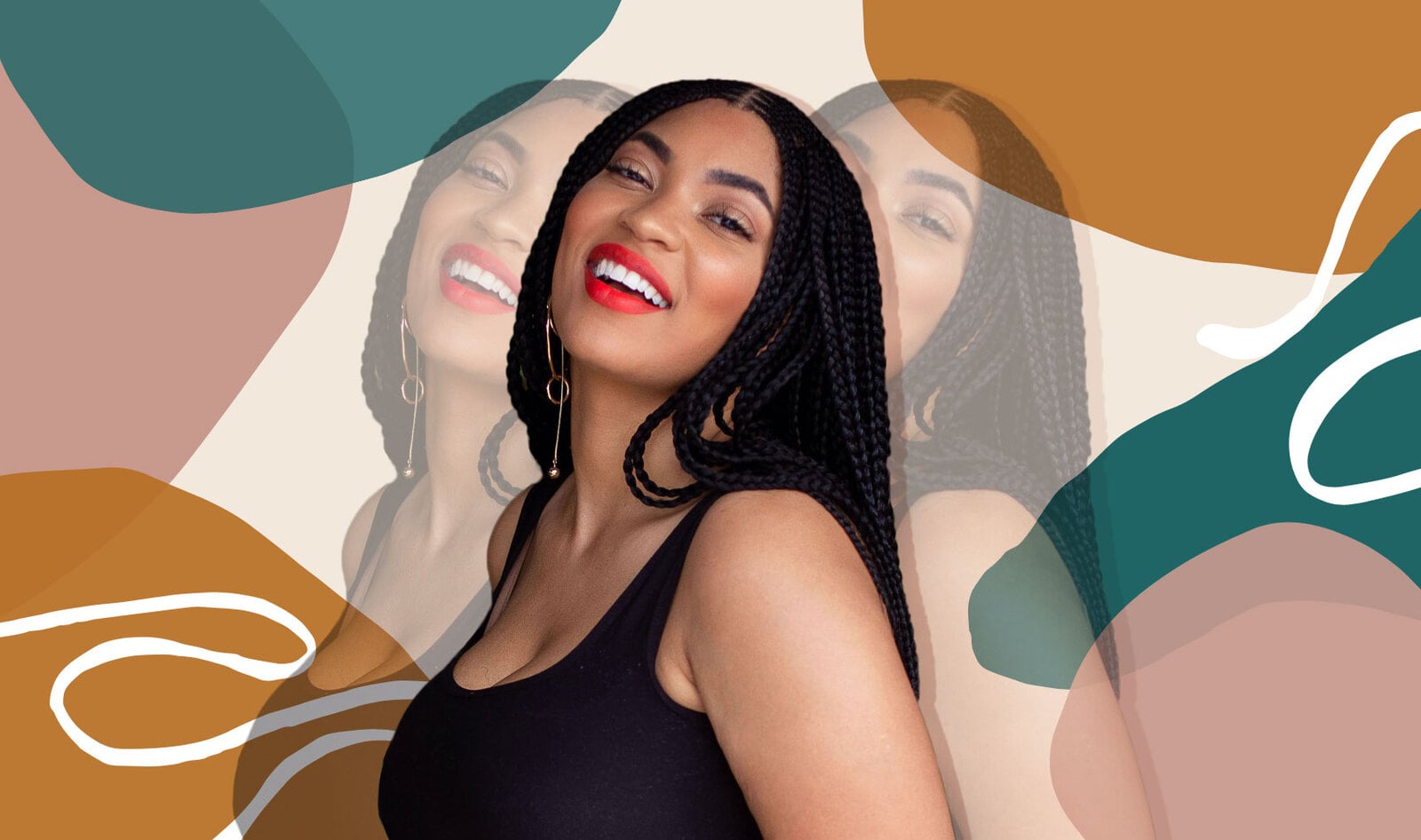
It’s been nearly two years since we started social distancing, staying home to make mountains of sourdough, Korean whipped coffees, and focaccia bread art. But for all the at-home deliciousness we’ve mastered, we’re ready for our favorite restaurants! We’re celebrating with a mouthwatering tour of the stories—and recipes—from some of the best-loved, Black-owned vegan restaurants in America. From soul food in Detroit to Ethiopian eats in Brooklyn to an all-vegan taqueria in Atlanta, get ready, because it’s time to eat.
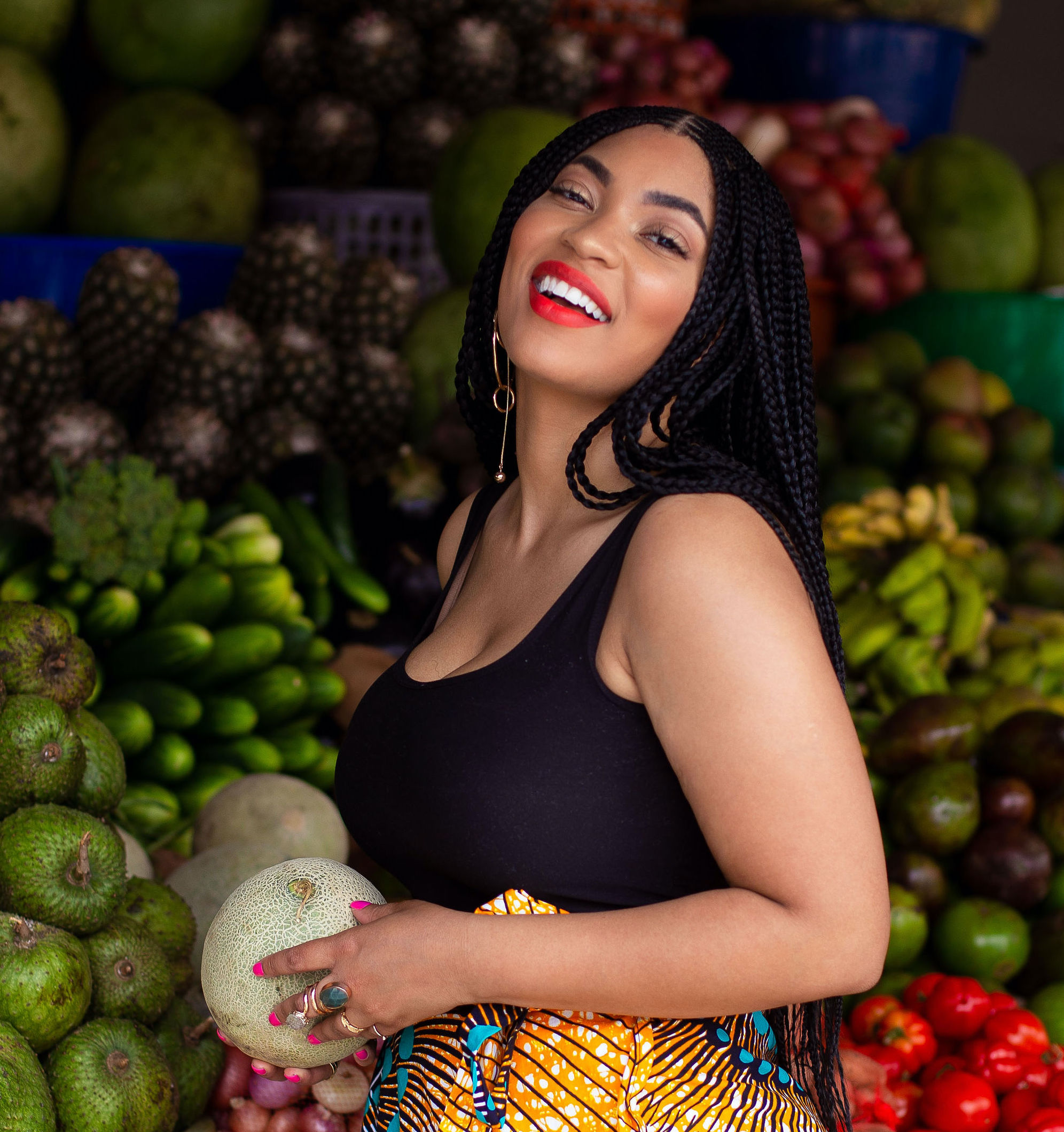 William Quartey
William Quartey
In a city where locals devour buttery peach pies, meaty barbecue, and pimento cheese-stuffed deviled eggs, a burgeoning plant-based scene is steadily brewing. The gone-viral burger chain Slutty Vegan helped put ATL on the map, while plant-based raw spots, Caribbean eateries, and even pizzerias have all been serving the city’s growing number of hungry herbivores. But Atlanta native Chris Hodge felt there was something missing. Weary of the hour-long lines at some of her favorite restaurants, in 2020, she sought inspiration from the Mexican food she loved and opened Chi Chi Vegan—Atlanta’s first vegan brick-and-mortar taqueria—serving tacos and tending to her own lines that wrap around the building.
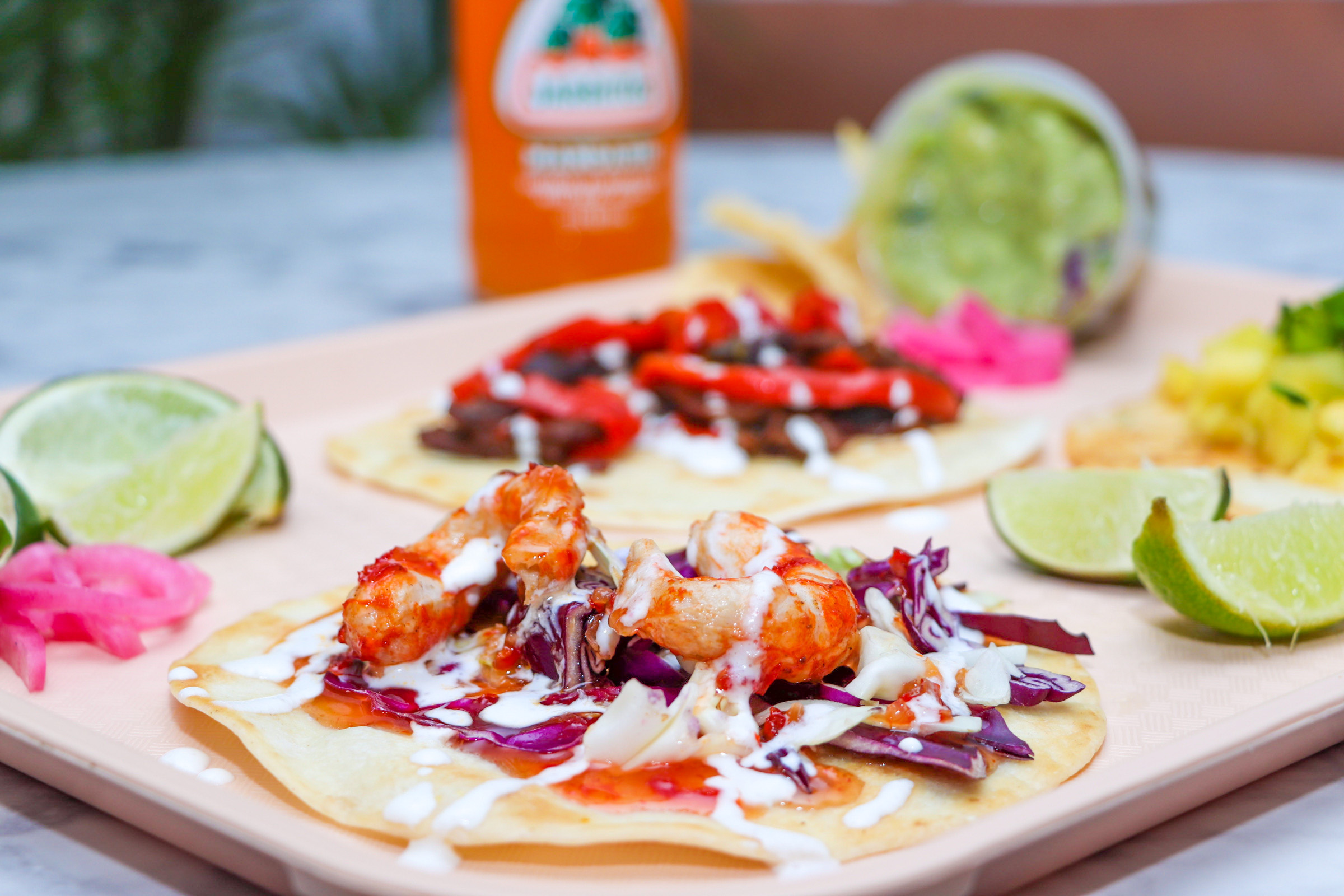
Trained and taught by home cooks during her travels in Mexico, Hodge uses simple ingredients to create deftly flavored proteins before enveloping them in warm, locally made tortillas. Craving traditional Mexican eats? Patrons can choose from Al Pastor & Pineapple tacos (made with soy protein, cilantro, onion, pineapple, and salsa roja), Baja Fish tacos (crispy fish topped with cabbage and sweet chili), or Chimichangas (a stuffed burrito with rice, beans, and fajita vegetables that’s fried and smothered in queso). Want something a little different? The Fried Green Tomato and Falafel tacos always deliver.
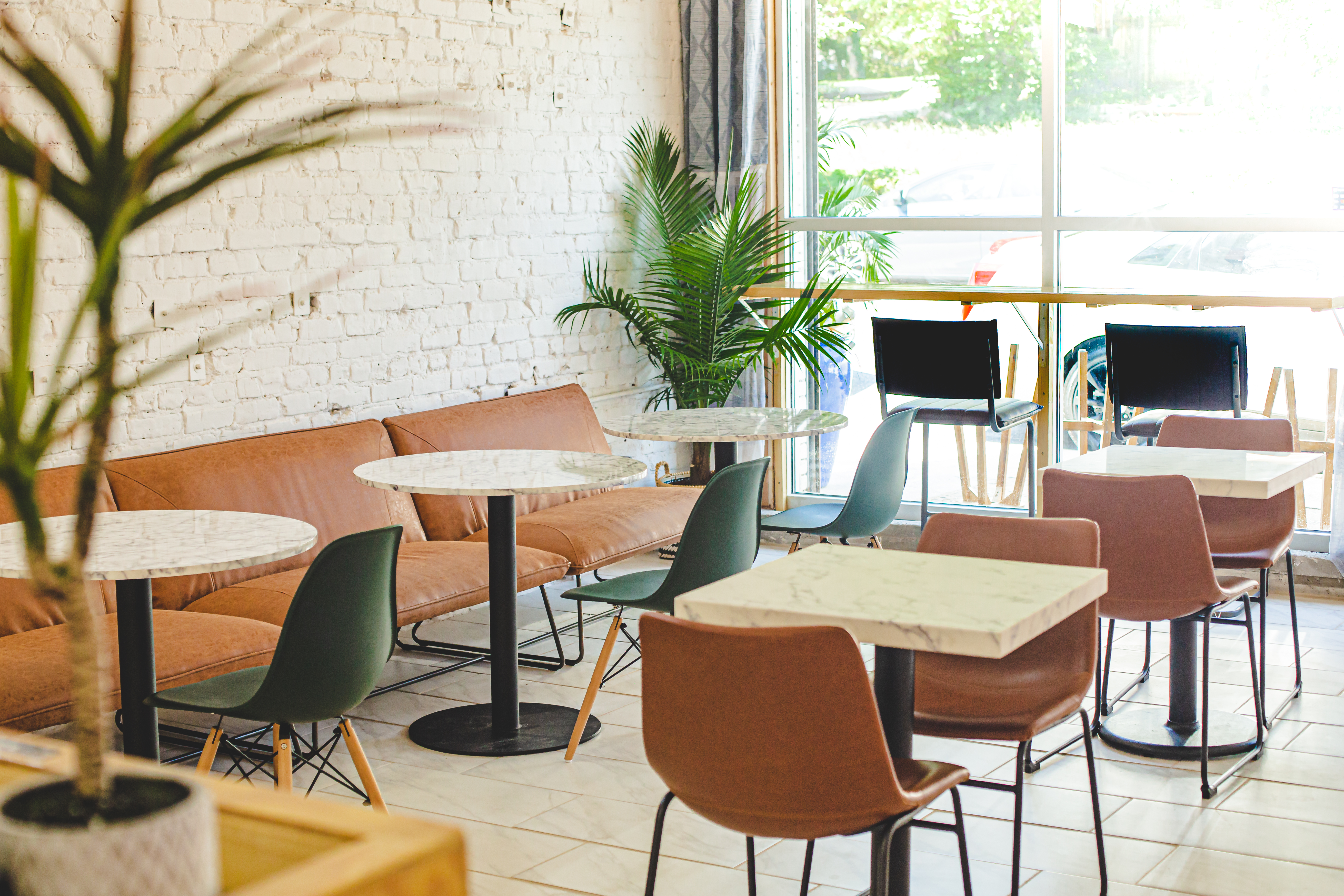
Most wouldn’t dare to dream of opening a brand-new business during a global pandemic—let alone actually do it. But for Hodge, Chi Chi is just the beginning. The taqueria (which is gearing up for a breakfast menu expansion) is just the first plant-based food and beverage brand under Noir Hospitality, Hodge’s company that she founded eight years ago. Next, she plans to open Sweet Chi Chi bakery—where she’ll sell tantalizing pastries and treats like sweet empanadas, churro waffles, and lemonade floats made with scoops of sorbet and tropical fruit—that will help both grow her plant-based empire and leave its mark on the Atlanta vegan foodscape.
Read the entire Great American Black Vegan Restaurant Tour feature in the Black Vegan issue of VegNews.
For more Black-owned vegan restaurants, read:How This Family-Run Vegan Restaurant Became a Harlem MainstayThis Food Truck Makes Some of the Best Vegan Burgers in LASisters Close Salon After a Decade to Open Vegan Restaurant
This post was originally published on VegNews.com.
I have people worried that as white writers they will be hit with “cultural appropriation” if they write a novel with characters who are not of their own race. You know the deal — writing about barrios, or ghettos or even a mix of people in a big city, people outside the lily white background of the author.
We know that is balderdash, to put it lightly. The cultural appropriation fear came up in a memoir writing class I teach. Memoirs, which are about people remembering a time in their lives with significance, tied to themes. They are about the person, and then, through their looking glass and through deep analysis, about how they experience the world. A memoir is what the person, the author, is remembering. So, for instance, I grew up all over the place, but say, when I was three or four, we were in the Azores. Of course, I have a right to write about my Portuguese “nanny” (babysitter). Or anything I learn/learned about Portugal.
Wrestling with my Mexican-American friends in high school in Tucson? Doing a sweat with my Apache friends up on the White River Apache Reservation? All the time I was in Central America, or in Mexico? These are off limits to me because I am Irish-German? Bull-shit!
The issue was broached by a student who was watching that Uncle Tom, Oprah, who had on her show the author of American Dirt. She wrote a novel about — Mexicans coming across the border. She’s white, and she got all the hype, a seven-figure advance, and she said her husband, too, was an undocumented immigrant, but the problem is that fellow is Irish. Lots and lots of hype, publicity, and $$. She was even a headliner for an annual Spokane literary festival, Get Lit, set for April 2020. I was also going to be there as small potatoes writer reading, but both she was cancelled, through her agent and publisher, and the event got hit with the Covid paranoia.
There’s no use in getting into the debate about how she may have done some “brown facing,” or the fact that minority and marginalized and BIPOC writers in the USA get short shafted when it comes to literary notice, literary contracts, big promo’s and the big bucks. I explained to my students that to have a panel of people who have studied cultural appropriation, who know the ins and outs of the bizarre debate about teaching history about blacks, women, Latinos, Asians, Native Americans, and such, and how they can debunk these anti-“critical race theory” racists, to have them there, talking, and then giving the students a chance to query and discuss, that is the only way to deal with the actual issue of cultural appropriation.
Here, the background:
Oprah Winfrey will soon host a conversation about “American Dirt,” a novel mired in controversy that’s also the latest selection for her book club.
It’s too little too late. Winfrey should rescind her support now.
In nearly 25 years, only once has the entertainment mogul yanked a coveted book club endorsement. That came in 2006, after James Frey’s memoir about his addiction and recovery, “A Million Little Pieces,” turned out to be far more fiction than fact.
“American Dirt” needs to be the second.
For months, Jeanine Cummins’s novel about a Mexican mother and her young son heading to the border to escape a drug cartel has been widely criticized in Latinx circles for perpetuating what writer and translator David Bowles calls a “pastiche of stereotypes and melodramatic tropes of the sort one might expect from an author who did not grow up within Mexican culture.”
Cummins has long identified as white. In interviews, she now mentions her Puerto Rican grandmother, and some headlines call her “a white Latina.” She says she deeply researched the book, including spending time in Mexico.
Yet this isn’t about how Cummins self-identifies. It’s about a novel fostering stereotypes, and what happens when communities of color get shut out from telling their own stories.
After a publishing industry bidding war, Cummins received a seven-figure advance, and the movie rights have been sold. Her novel received glowing blurbs from Stephen King and John Grisham. She got a major credibility boost from acclaimed Latinx authors Sandra Cisneros, who called the book “masterful,” and Julia Alvarez, who said it’s “a dazzling accomplishment.” All appear on the book’s back cover.
In the ensuing debate, neither Cisneros nor Alvarez have stepped forward to defend a book to which they lent their names and, especially, their reputations. — Renée Graham Globe Columnist,Updated January 28, 2020
I get where this entire thing comes down to (bad writing, white woman with no real ground-living/ground-truthing). And without shooting myself in the foot, me being a white guy who happens to know where I have been, for whom the people I have been with, what those close relationships I have fostered — with people way outside my demographic — have taught me about them and myself. I get how I stick out like a sore thumb when dealing with academic types, with university types, with those in MFA writing programs. I have been cancelled and delegitimzed my entire life. My stories and my characters in stories are my characters. Having to tell me that I have only the right to write about my own people and gender (heterosexual white as is my family/blood) is absurd. But I get the reactions to this white privilege in publishing, but I also hate what the MFA Writing Programs have done to writers and writing the past 30 years. I hate the barbaric thinking on both sides of this debate. And Oprah? I am an anti-capitalist and anti-imperialist, and I wonder what Malcolm X might think of the current affairs of this rot-gut country? Billionaire? Oprah? The make or break literary arbiter?
The fact is just two days ago, we get the Oregon news around the education outcomes of Black students in Multnomah County.
Part of why Portland’s Black and Latino students are so vastly underrepresented in advanced courses, parents of color say, is that many teachers, counselors and other educators assume those students aren’t smart or skilled enough to handle the challenge.
Low expectations and a lack of structural support for Black and Latino students also continue to lead to persistently low graduation and college-going rates for those groups, an analysis by The Oregonian/OregonLive has found.
That is true even though the district’s top leaders pledged nearly 2 ½ years ago that they would dramatically boost Black and Latino student achievement by this year.
Despite making up about 7% of the overall student population, Black students represent about 1% of those who took advanced courses this school year and last, district figures show.
And even though Latinos make up about 16% or 17% of district enrollment, they represent about 8% of those taking advanced courses. (“Left Behind: Low expectations, lackluster education for high school students of color in Portland span decades” — Oregonian)
This is 2022, not 1964 when Malcolm X did his The Ballot or the Bullet speech.
I am not embarrassed or ashamed of the white crackers in this country, whether they are dirt poor crackers or rich as kings crackers. Racists, sexists, ageists, they all are a bunch of privileged fools. But they hate. Most people I know of never ever go into a cracker bar with a bunch of Harleys outside. I do. And the shit coming out of these people’s racist mouths is consistent with their country’s history of killing and killing. So embarrassed? Why? These people are the natural (sic) outgrowth of who they are (their roots, lineages); where they came from (forefatherrs the superstitious colonizers); and how they have developed (on the muscle and brawn and graves of slaves and First Nations). Bad-bad folks. Yes, there are deplorables in the mix, just not the way that white racist Hillary was thinking about! So, this is a story from 2022. Imagine that, Kansas:

Just a few days ago:
A Kansas principal was allegedly forced to apologize to high school staff after showing them a video about white privilege, KMUW reports.
The incident started in January when Principal Tim Hamblin reportedly showed Derby High School staff a 2011 video focused on the perspectives of Dr. Joy DeGruy. DeGruy, who is a Black author, spoke about her personal experiences with racism and white privilege.
The story was about her being forced to present identification to a grocery store cashier, while her sister-in-law, who has a fair complexion, did not have to do such a thing. The relative ended up calling out the store manager and staff for racism.
“She used her white privilege to educate and make right a situation that was wrong,” DeGruy says in the footage. “That’s what you can do every single day.” (source)
I’ve been in meetings and conferences with DeGruy. An amazing person. Is it just Kansas? The putz apologizes? This is one sick country — and the sickness is deep:
What would Malcolm X think or say? About this shit in this day and age?
What would Malcolm X think about this government overreach, the Klanadians and lockdowns? How would Malcolm C see these white Klanadians — really, who they are — as compared to who the Americans are? The same side of the same coin? Beware of Trudeau and beware of most of the truckers. Vaccination status and crossing the US-Canada border and mandates are not the ONLY issues for which they have axes to grind. Go a little deep with Canadians, about the theft/rape of the land, about the ravaging of First Nations’ land and culture, about really their country’s thuggish ways, from RCMP, the RCAF, well, you might just find yourself at the wrong end of the grill on that big Volvo 18-wheeler. How in god’s name do any Canadians run around with Trump flags? The tail and the dog and the pile of you know what — Canada-USA-UK!
From Workers World: “This movement has become, in a few days, a symbol for all those who are more and more shocked by everything that is happening in our society, but who — and this should not be underestimated — are also more and more attracted to right-wing and even extreme right-wing movements.
“These trucker convoys, which fail to raise the key work issues of truck drivers in both countries, are being well financed by U.S. reactionary movements and getting tremendous business media attention. Meanwhile, Big Media is barely acknowledging the enormous U.S. worker resurgence underway and growing — the strike wave this past fall, massive education and health worker organizing, the unionization struggle spreading like wildfire through Starbucks, the drive to unionize Amazon, one of the biggest high tech exploiters in the world. Working-class activists can take heart from these developments and more.”
+–+
Here, from . . . . Kanyenkehaka (Mohawk) is from the Tehanakarineh family of the Bear Clan. His home is in Tyendinaga Mohawk Territory, but he currently resides at the Six Nations of the Grand River Territory (near Hamilton, Ontario). He is an Onkwehon:we (Indigenous) man and belongs to the Kayenkehaka Nation, not the Canadian or English nation. His people have kept their ways and traditions, and despite generations of mistreatment at the hands of the Canadian government, they remain a separate, allied Nation with their own rights and responsibilities to creation.
For all of you who don’t have a clue what I’m talking about, maybe you’re new to this country. They didn’t teach you that Indigenous people own these lands. They’ll tell you that it’s theirs. It’s Canada’s wonderful free place. It was only free because they stole things. I’m talking to all the brown people in the cities that didn’t want to go and support the truckers because they thought they were racist. Well, the Liberal Government’s racist and so is the Conservative Government. The entire government of Canada is racist. And the RCMP are racist. Let’s face the facts the RCMP are just as much a culprit in the in the theft of the indigenous children that got sent to residential schools, because they were the collectors.
Here, the Latinx calling out “American Dirt”: Myriam Gurba,

When I tell gringos that my Mexican grandfather worked as a publicist, the news silences them.
Shocked facial expressions follow suit.
Their heads look ready to explode and I can tell they’re thinking, “In Mexico, there are PUBLICISTS?!”
I wryly grin at these fulanos and let my smile speak on my behalf. It answers, “Yes, bitch, in México, there are things to publicize such as our own fucking opinions about YOU.”
I follow in the cocky footsteps of my grandfather, Ricardo Serrano Ríos, “decano de los publicistas de Jalisco[1],” and not only do I have opinions, I bark them como itzcuintli. También soy chismosa and if you don’t have the gift of Spanglish, allow me to translate. “Chisme” means gossip. It’s my preferred art form, one I began practicing soon after my period first stained my calzones, and what’s literature, and literary criticism, if not painstakingly aestheticized chisme?
Tengo chisme. Are you ready?
A self-professed gabacha, Jeanine Cummins, wrote a book that sucks. Big time.
Her obra de caca belongs to the great American tradition of doing the following:
Rather than look us in the eye, many gabachos prefer to look down their noses at us. Rather than face that we are their moral and intellectual equals, they happily pity us. Pity is what inspires their sweet tooth for Mexican pain, a craving many of them hide. This denial motivates their spending habits, resulting in a preference for trauma porn that wears a social justice fig leaf. To satisfy this demand, Cummins tossed together American Dirt, a “road thriller” that wears an I’m-giving-a-voice-to-the-voiceless-masses merkin.
I learned about Dirt when an editor at a feminist magazine invited me to review it.
I accepted her offer, Dirt arrived in my mailbox, and I tossed it in my suitcase. At my tía’s house in Guadalajara, I opened the book.
Before giving me a chance to turn to chapter one, a publisher’s letter made me wince.
“The first time Jeanine and I ever talked on the phone,” the publisher gushed, “she said migrants at the Mexican border were being portrayed as a ‘faceless brown mass.’ She said she wanted to give these people a face.”
The phrase “these people” pissed me off so bad my blood became carbonated.
I looked up, at a mirror hanging on my tía’s wall.
It reflected my face.
In order to choke down Dirt, I developed a survival strategy. It required that I give myself over to the project of zealously hate-reading the book, filling its margins with phrases like “Pendeja, please.” That’s a Spanglish analogue for “Bitch, please.”
Back in Alta California, I sat at my kitchen table and penned my review. I submitted it. Waited.
After a few days, an editor responded. She wrote that though my takedown of Dirt was “spectacular,” I lacked the fame to pen something so “negative.” She offered to reconsider if I changed my wording, if I wrote “something redeeming.”
In the end, though, it’s Black History Month. Anyone with any worth should listen to Malcolm X’s talk, “The Ballot or the Bullet.” Goddamn it, listen.
I’m not a politician, not even a student of politics; in fact, I’m not a student of much of anything. I’m not a Democrat. I’m not a Republican, and I don’t even consider myself an American. If you and I were Americans, there’d be no problem. Those Honkies that just got off the boat, they’re already Americans; Polacks are already Americans; the Italian refugees are already Americans. Everything that came out of Europe, every blue-eyed thing, is already an American. And as long as you and I have been over here, we aren’t Americans yet.
Well, I am one who doesn’t believe in deluding myself. I’m not going to sit at your table and watch you eat, with nothing on my plate, and call myself a diner. Sitting at the table doesn’t make you a diner, unless you eat some of what’s on that plate. Being here in America doesn’t make you an American. Being born here in America doesn’t make you an American. Why, if birth made you American, you wouldn’t need any legislation; you wouldn’t need any amendments to the Constitution; you wouldn’t be faced with civil-rights filibustering in Washington, D.C., right now. They don’t have to pass civil-rights legislation to make a Polack an American.
No, I’m not an American. I’m one of the 22 million black people who are the victims of Americanism. One of the 22 million black people who are the victims of democracy, nothing but disguised hypocrisy. So, I’m not standing here speaking to you as an American, or a patriot, or a flag-saluter, or a flag-waver — no, not I. I’m speaking as a victim of this American system. And I see America through the eyes of the victim. I don’t see any American dream; I see an American nightmare.
These 22 million victims are waking up. Their eyes are coming open. They’re beginning to see what they used to only look at. They’re becoming politically mature. They are realizing that there are new political trends from coast to coast. As they see these new political trends, it’s possible for them to see that every time there’s an election the races are so close that they have to have a recount. They had to recount in Massachusetts to see who was going to be governor, it was so close. It was the same way in Rhode Island, in Minnesota, and in many other parts of the country. And the same with Kennedy and Nixon when they ran for president. It was so close they had to count all over again. Well, what does this mean? It means that when white people are evenly divided, and black people have a bloc of votes of their own, it is left up to them to determine who’s going to sit in the White House and who’s going to be in the dog house. (transcript here)
Ahh, some Mexican writers have called this latest book on today’s Mexico, one of the best. Written by, well, Theroux, the old white guy!
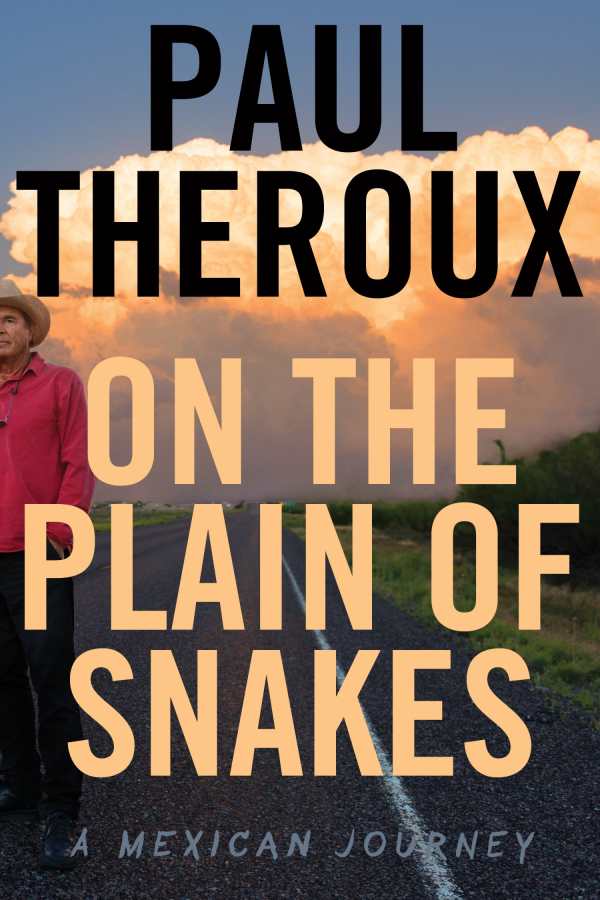
Theroux then goes deep into the hinterland, on the back roads of Chiapas and Oaxaca, to uncover the rich, layered world behind today’s brutal headlines.
He meets with the legendary Subcomandante Marcos, leader of the Zapatista movement dedicated to defending the rights of Mexico’s indigenous people. ON THE PLAIN OF SNAKES: A Mexican Journey is replete with adventures, history, discursions on literature about Mexico, stunning descriptions and, running through it all, a deep humanity and respect for the ordinary Mexicans who are his main subject.
Paul Theroux has been called “The world’s most perceptive travel writer”. He is the author of many highly acclaimed works of fiction and nonfiction, including The Great Railway Bazaar, The Mosquito Coast and Riding the Iron Rooster. We spoke with him last about his book Deep South.
Interview here of Paul Theroux: Source/Podcast.
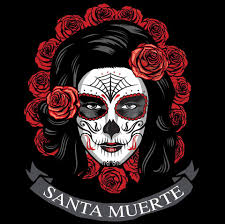
What would Malcolm X say?
So, what I’m trying to impress upon you, in essence, is this: You and I in America are faced not with a segregationist conspiracy, we’re faced with a government conspiracy. Everyone who’s filibustering is a senator — that’s the government. Everyone who’s finagling in Washington, D.C., is a congressman — that’s the government. You don’t have anybody putting blocks in your path but people who are a part of the government. The same government that you go abroad to fight for and die for is the government that is in a conspiracy to deprive you of your voting rights, deprive you of your economic opportunities, deprive you of decent housing, deprive you of decent education. You don’t need to go to the employer alone, it is the government itself, the government of America, that is responsible for the oppression and exploitation and degradation of black people in this country. And you should drop it in their lap. This government has failed the Negro. This so-called democracy has failed the Negro. And all these white liberals have definitely failed the Negro.
See/read the initial Black History Month piece by yours truly: “To the Victor Go the Spoils“, DV, February 5th, 2022
This post was originally published on Dissident Voice.
On January 31, 2022, New York magazine published an article by Sean Campbell, “The BLM Mystery: Where did the money go?” A core demand of the article is one that many have made for many years: Show me the money! People have questions. I have a lot of answers. I am a former, and still supportive organizer in a legacy chapter (my own term) of Black Lives Matter – BLM Philly. I represented the chapter in the national network – the place that BLM Global Foundation in its several formations curated. Up until my separation from the chapter in late 2021, BLMGN was the owner/manager/user of the primary website BlackLivesMatter.com, along with the social media and the newsletter.
The post An Insider Perspective In The Black Lives Matter Global Network Sham appeared first on PopularResistance.Org.
This post was originally published on PopularResistance.Org.
On 17 February, Labour’s deputy leader Angela Rayner announced the party’s “hardline” approach to law and order. In a shocking statement, the deputy leader urged terror police to “shoot first” and “ask questions second”. People soon took to Twitter to express outrage at Rayner’s disgraceful comments.
Appearing on Matt Forde’s Political Party podcast, Rayner said:
On things like law and order I am quite hardline. I am like, shoot your terrorists and ask questions second.
Explaining her “hardline” approach to law and order, Rayner added:
I want you to beat down the door of the criminals and sort them out and antagonise them. That’s what I say to my local police … three o’clock in the morning and antagonise them.
The Black Lives Matter movement saw a resurgence in 2020 following the police killing of George Floyd in the US. Anti-racist campaigners in the UK highlighted the police’s disproportionate criminalisation and use of force against Black people in this country, particularly those with special educational needs and disabilities or experiencing mental health crises.
A central demand of the anti-racist movement remains a move away from punitive and draconian reactions to criminal justice issues, towards healing and community-centred solutions.
Rayner was among the countless neoliberals to perform solidarity with the anti-racist movement at its peak. In 2020, she expressed solidarity by taking the knee in a bizarre photo opportunity with Labour leader Kier Starmer.
Pointing out Rayner’s bare-faced hypocrisy on the matter, independent media outlet Another Angry Voice shared:
She performatively took a knee for Black Lives Matter …
Then she chuckled away with her grotesque Blairite mate about instilling a "shoot first, think later" mentality in the police, without a single thought about what such a policy would mean for people of colour. pic.twitter.com/h70qZBeY1t
— Another Angry Voice (@Angry_Voice) February 17, 2022
And The Canary‘s former editor-at-large Kerry-Anne Mendoza said:
We cannot let Centrist Labour into power in Westminster.
A “Shoot first, ask questions later” police policy is a death sentence for countless people of colour, especially traumatised, disabled & mentally ill.
Didn’t they kill enough of us last time they were in government? Ffs
— Kerry-Anne Mendoza
(@TheMendozaWoman) February 17, 2022
Indeed, Rayner’s latest remarks echo Tony Blair’s ‘tough on crime’ approach to criminal justice issues. Blair’s punitive anti-crime policies and legislation created a boom in England and Wales’ prison population, and criminalised many people suffering from addiction and experiencing mental health issues.
Further, evidence demonstrates that such approaches fail to reduce crime.
Others took to Twitter to highlight the fact that the UK’s terror police already enacts Rayner’s suggested ‘shoot first, ask questions later’ policy. Former chief prosecutor Nazir Afzal shared: Former chief prosecutor for North West England Nazir Afzal shared:
Some making out Angela Rayner’s comments about shoot first policy for terrorists is some new policy
It’s been operational anti-terror response to “marauding terrorist threats” for yrs
If faced with man wearing what purports to be “suicide vest” you disable to prevent greater harm— nazir afzal (@nazirafzal) February 17, 2022
This is exemplified by the tragic case of Jean Charles de Menezes. In 2005, armed police mistook the Brazilian electrician for a suicide bomber, shooting him seven times at close range and killing him in Stockwell station.
Raising this point, Novara‘s co-founder James Butler tweeted:
The "shoot first" approach lauded by Rayner here led to the police murder of Jean Charles de Menezes in 2005. It would be good if Labour politicians engaged either their brain or their conscience before inane hardman electoral posturing in the press. https://t.co/Obeymfzg45
— James B (@piercepenniless) February 17, 2022
Sam Browse shared:
I walk past this everyday on the way to work. I do not think “shoot first” should be anyone’s approach to these issues. pic.twitter.com/qSPnxmDNXC
— Sam Browse
(@SamBrowse) February 17, 2022
And there was this reminder on the 50th anniversary of Bloody Sunday in Derry:
On the 50th anniversary of Bloody Sunday, 17 years after the killing of Jean Charles de Menezes, Angela Rayner is very keen for our brave security forces to gun down whichever British citizens they consider in that moment to be a "terrorist". https://t.co/K7s6c8vwea
— Nick (@Nickiquote) February 17, 2022
Research consultant and Hackney-based activist Heather Mendick set out the only logical response to Rayner’s heinous remarks:
Deselect Labour MPs who support extrajudicial killing, ask questions later.
— Heather Mendick (@helensclegel) February 17, 2022
All in all, this represents a new low for Starmer’s increasingly right-wing Labour Party.
Featured image via Sky News/YouTube
This post was originally published on The Canary.
Protesters again took to the streets of Minneapolis, Minnesota — where George Floyd was murdered by cops in 2020 — demanding justice for a young Black man killed by the police, reports Malik Miah.
This post was originally published on Green Left.
February 14 marks 18 years since young Kamilaroi man TJ Hickey died after being chased by police. No one has been charged; his family is yet to receive any justice, writes Isaac Nellist.
This post was originally published on Green Left.
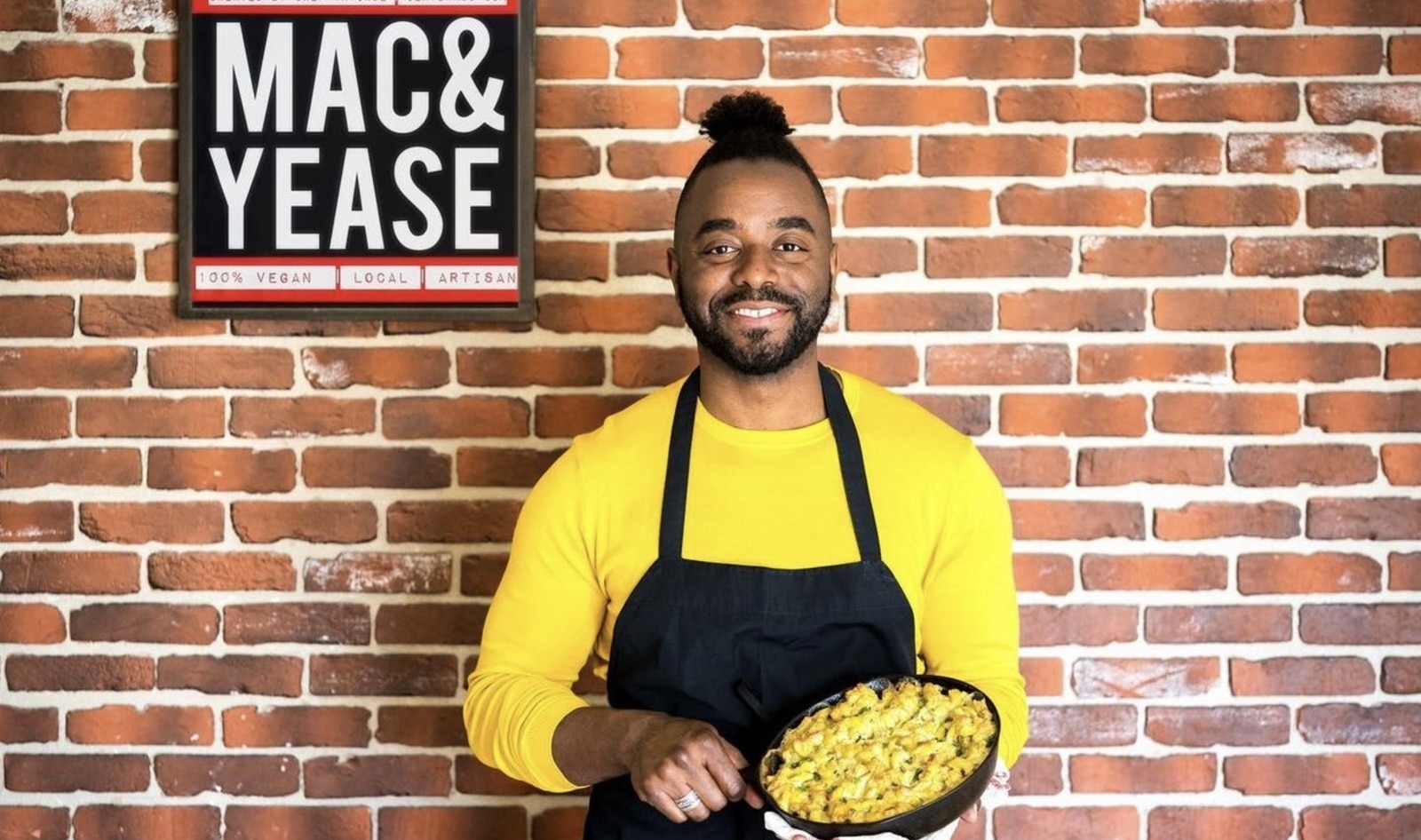
If there’s one thing the food industry can’t deny, it’s the power of consumers’ dollars. As we celebrate the history, achievements, and influence of the Black community during Black History Month—and throughout the year—we are reminded of the importance of supporting entrepreneurs from diverse cultures and backgrounds. By doing so, not only are we investing in the product but we’re also championing inclusivity within the industry. This month is an opportunity to uplift Black creators and businesses, increase awareness of their brands, and advocate for change.
The opportunities for Black entrepreneurs to launch their vegan businesses has never been better. People of color are reducing their consumption of meat faster than other demographics, according to a poll conducted by Gallup in 2020. And Black hip-hop artists and other celebs are investing in businesses that align with their meatless lifestyles. Beyoncé co-founded vegan meal delivery brand 22 Day Nutrition—that has since expanded to a meal-planning app—with vegan nutritionist Marco Borges, following her own experience with Borges’ 22 Day Nutrition challenge, in which she and husband Jay-Z ate a plant-based diet for three weeks. Jay-Z has invested in vegan brands such as Partake Foods and Impossible Foods through his venture capital firm. Musician Jaden Smith, son of celebrity couple Will and Jada Pinkett Smith, launched vegan food truck I Love You Restaurant that serves free food to the homeless. And world champion race car driver Lewis Hamilton—who often uses his platform to advocate for animal welfare and veganism—opened vegan burger restaurant Neat Burger in London, United Kingdom, with plans to expand globally.
To honor and support the growing list of vegan Black-owned businesses, we’ve rounded up a few you can order from that ship nationwide.
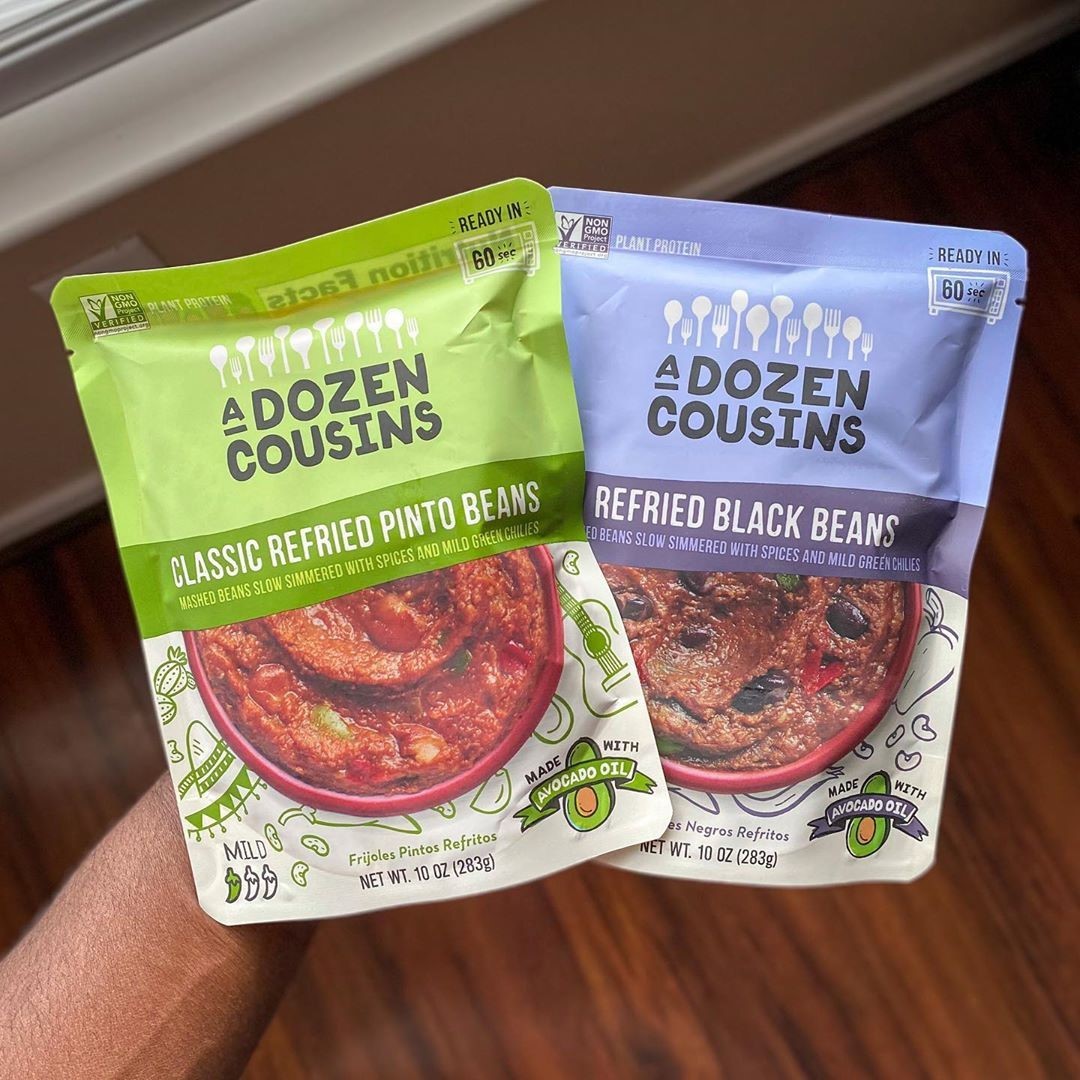 A Dozen Cousins
A Dozen Cousins
These slow-cooked, ready-to-eat beans make use of one of our favorite plant proteins. Inspired by Black and Latino recipes, they come in flavors such as Cuban Black Beans, Trini Chickpea Curry, and Mexican Cowboy Beans, as well as classic Refried Beans. Plus, because many Americans in underserved communities don’t have access to healthy food, A Dozen Cousins provides an annual grant and volunteer support to nonprofits working to eliminate socio-economic health disparities in the country.
Shop here
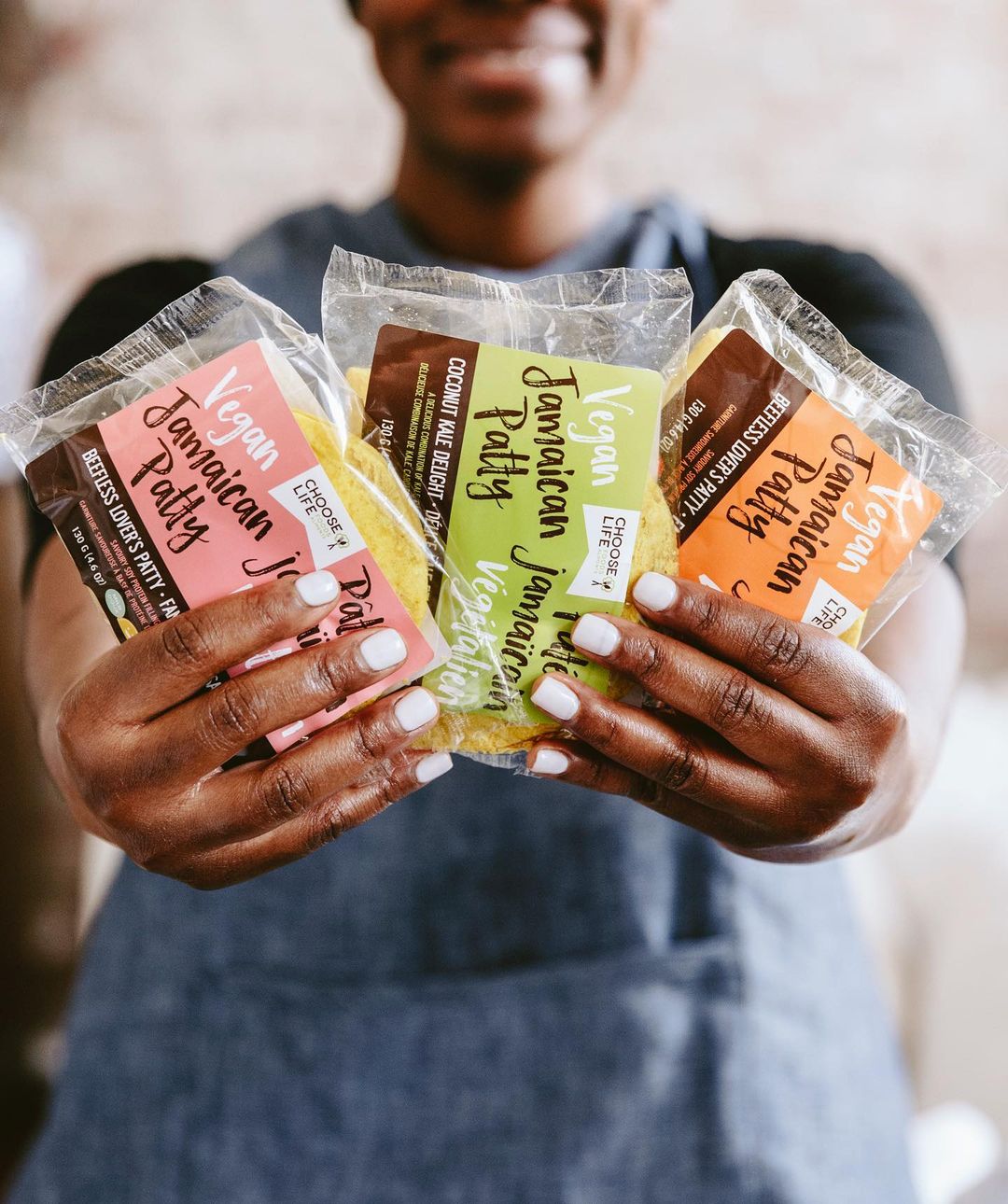 Choose Life Foods
Choose Life Foods
These vegan Jamaican patties were born out of a desire to veganize the authentic patties founder Carolyn Simon—who is referred to as the company’s “Patty Queen”—ate growing up, and the Beefless Lover’s Patty and Coconut Kale Delight flavors are the result.
Shop here
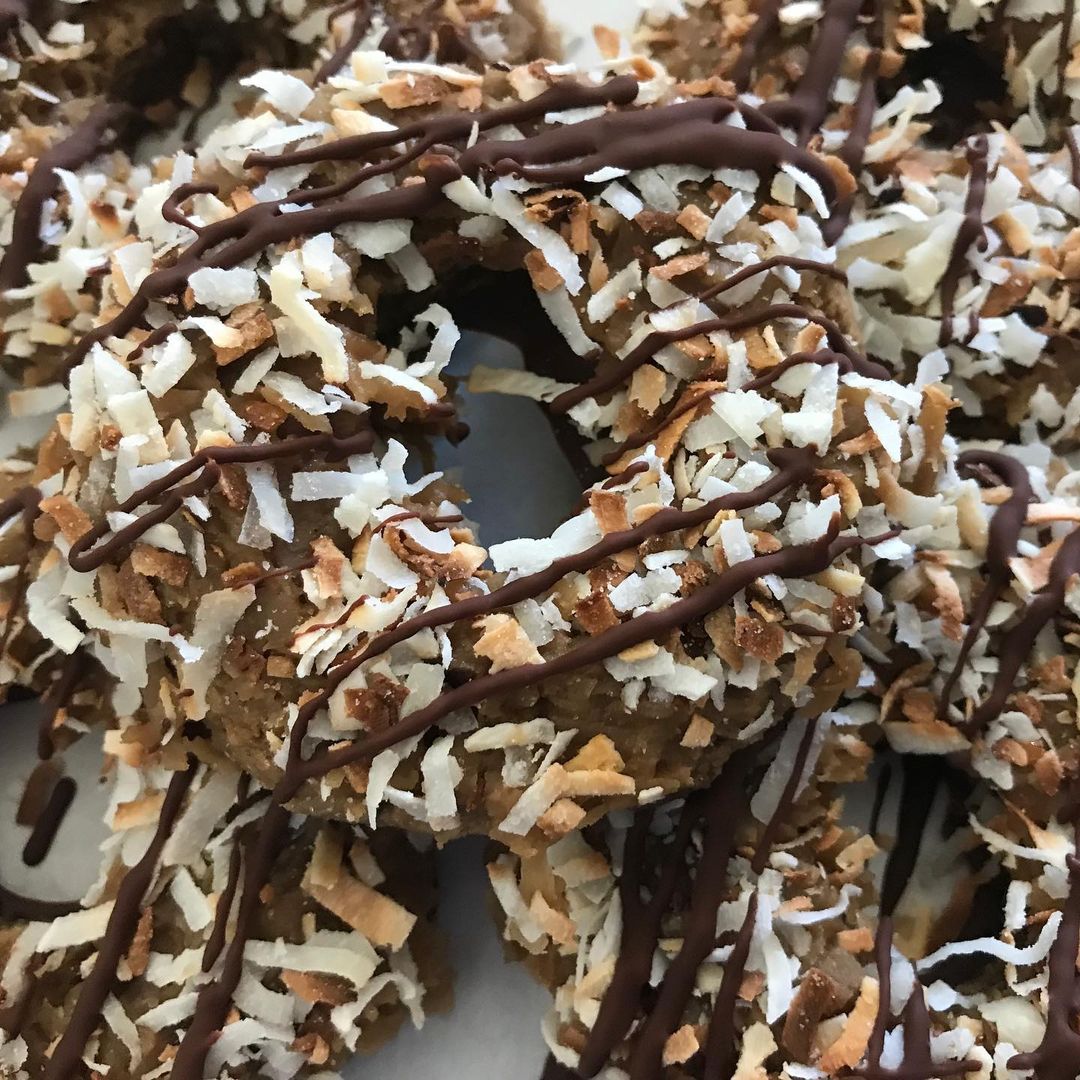 Coco Luv Vegan Cookies
Coco Luv Vegan Cookies
Though this Los Angeles-based, family-owned company calls itself a cookie company, there’s far more on the menu. From cookie pies and Coco Dream Ding Dongs to entire Oreo Cakes, you’ll have a hard time choosing what to order. Know someone who has a birthday this month? Get the Cinnamon Roll Cake with Sprinkles delivered to their door.
Shop here
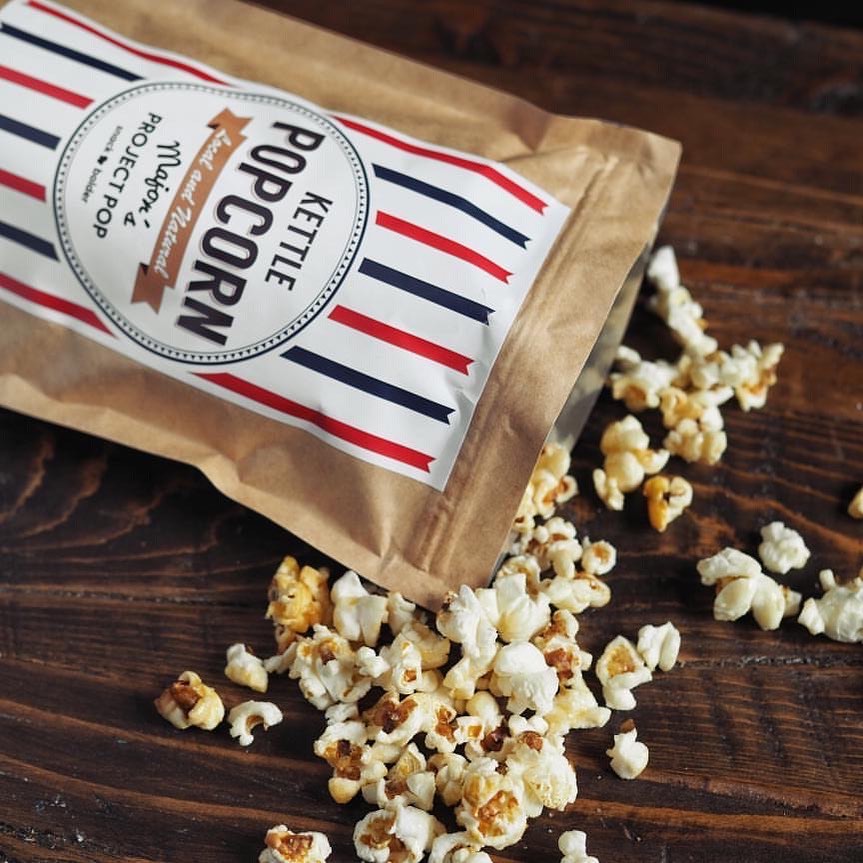 Major Project Pop
Major Project Pop
A fresh vegan take on kettle corn, Major’s Project Pop makes its main product in small batches and keeps it real with simple ingredients—namely, virgin coconut oil, vegan cane sugar, and Himalayan salt. The company gives back to its community by supporting non-profit initiatives such as Feeding Children Everywhere and the National Black Food & Justice Alliance. This month, Project Pop is also selling Black History Month merch with their “People over Profit” tagline.
Shop here
 Good Girl Chocolate
Good Girl Chocolate
Dr. Tabatha Carr created Good Girl Chocolate in an effort to support her healthy lifestyle—and her sweet tooth. The good-for-you product line ranges from vegan milk chocolate to caramel cake truffles. Plus, 5 percent of sales go towards supporting underprivileged orphanage children in Haiti.
Shop here
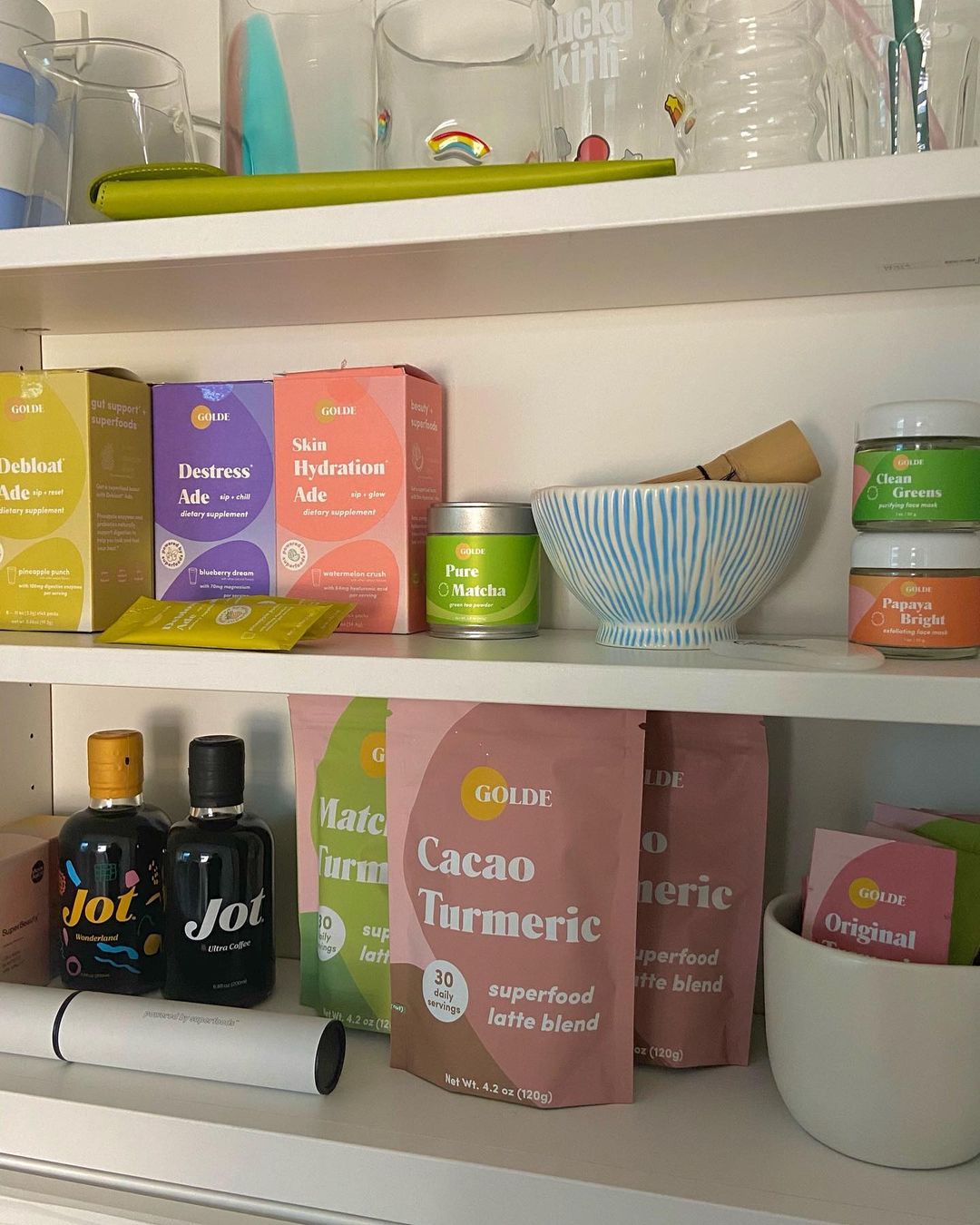 Golde
Golde
This small but mighty Brooklyn, NY-based business launched with a single product—Original Turmeric Latte Blend—and has since expanded to other superfood essentials from face masks to drink mixes.
Shop here
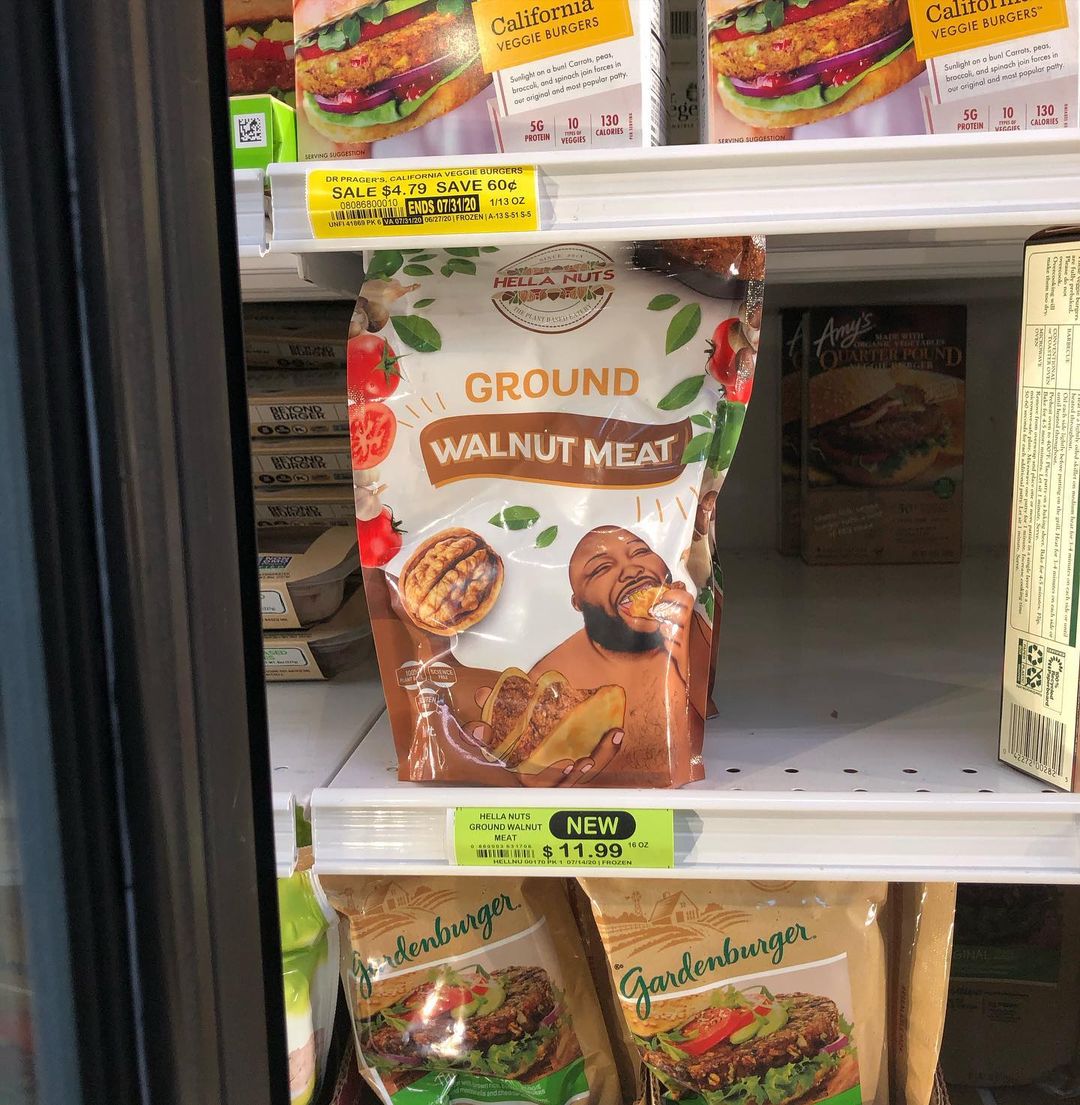 Hella Nuts
Hella Nuts
This plant-based eatery has created a patent-pending vegan ground meat made from walnuts. We’re already making a list of dishes to make with it, starting with tacos, shepherd’s pie, and stuffed bell peppers.
Shop here
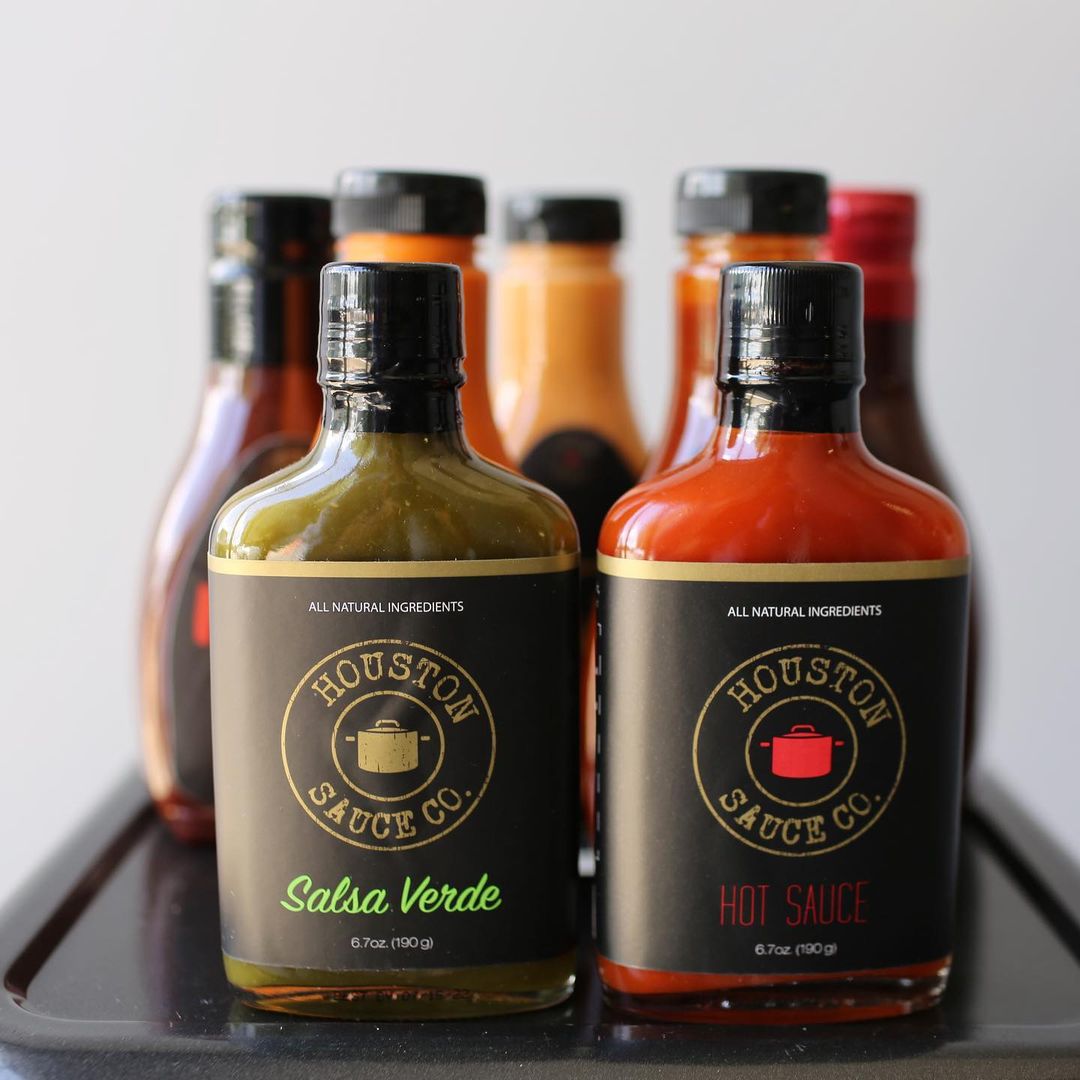 Houston Sauce Co.
Houston Sauce Co.
This sauce-company-turned-food-truck specializes in hot sauces and vegan barbecue. If you’re not able to get your hands on their vegan Dirty Bird Chik’n Sandwich or Philly Cheesesteaks in Houston, check out their online store, where you can order hot sauces and other tasty vegan snacks and get them shipped to your door.
Shop here
 Mac & Yease
Mac & Yease
Vegan chef Ayindè Howell popularized his vegan mac and cheese and it has since hit hot bars in retailers such as Whole Foods Market. You can now order your own family-sized frozen meals online and choose from jalapeño Mac and Yease to BKLN Bolognese.
Shop here
 Maya’s Cookies
Maya’s Cookies
This beloved vegan bakery recently opened its first storefront in San Diego, CA, but it also sells its handmade gourmet cookies online, at farmers’ markets, and in select retailers. We especially love Maya’s Black History Month cookie collection in honor of prominent figures in the Black community.
Shop here
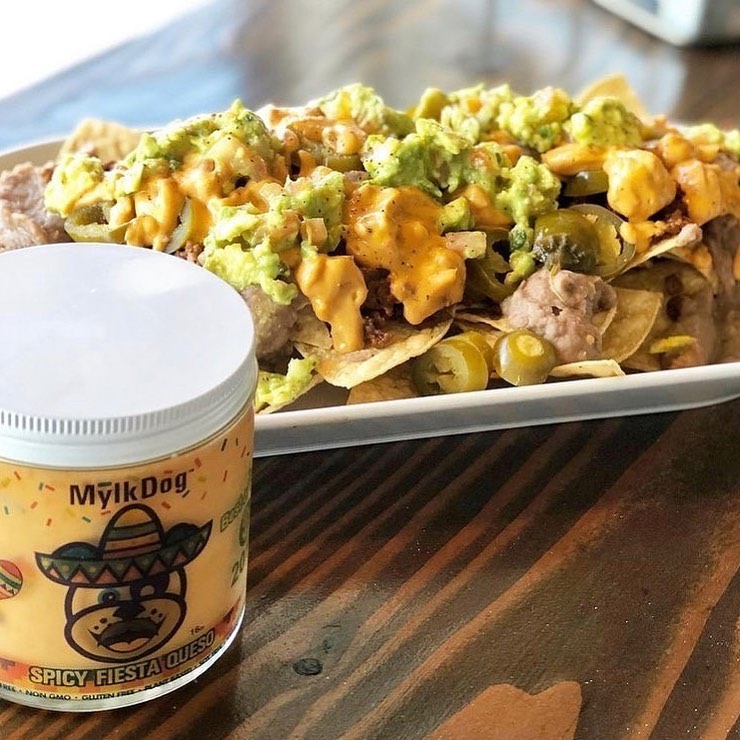 Mylk Dog
Mylk Dog
Founder Bethovan Enhancing grew up devouring jars of nacho cheese, but when he and his family ditched dairy, he was determined to create an alternative. Enter Mylk Dog Notcho Cheez, made from simple ingredients such as almond milk, cashews, bell peppers, and nutritional yeast.
Shop here
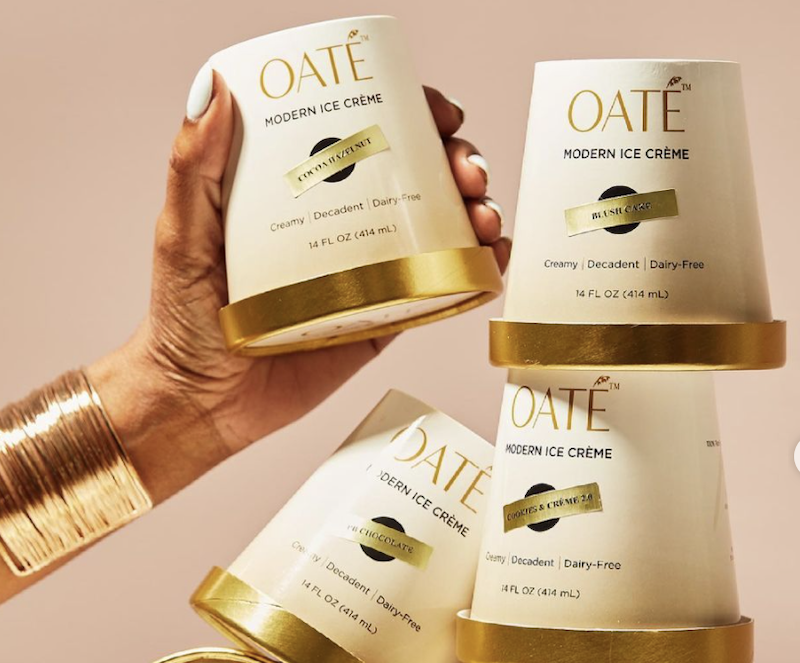 Whipped Urban Dessert Lab
Whipped Urban Dessert Lab
From the founders of New York-based Whipped Urban Dessert Lab comes Oaté, a line of “ice crème” pints available for nationwide shipping through Goldbelly. Founded by sisters Courtney Blagrove and Zan B.R., Whipped Urban Dessert Lab made headlines for being the first ice cream shop to make oat milk soft serve. Can’t justify flying to New York for a creamy swirled cone? Oaté pints are sure to satisfy all sweet tooth cravings.
Shop here
 Rooted Delights
Rooted Delights
Though Rooted Delights first launched as a food truck in Baltimore, MD, in 2018 founder Janay Jones decided to move back to her hometown of Richmond, VA and focus on launching a vegan cheese line. Made from oat milk, the Rooted Delights cheese line is currently available in Creamy Mozzah and Milk Cheddah flavors.
Shop here
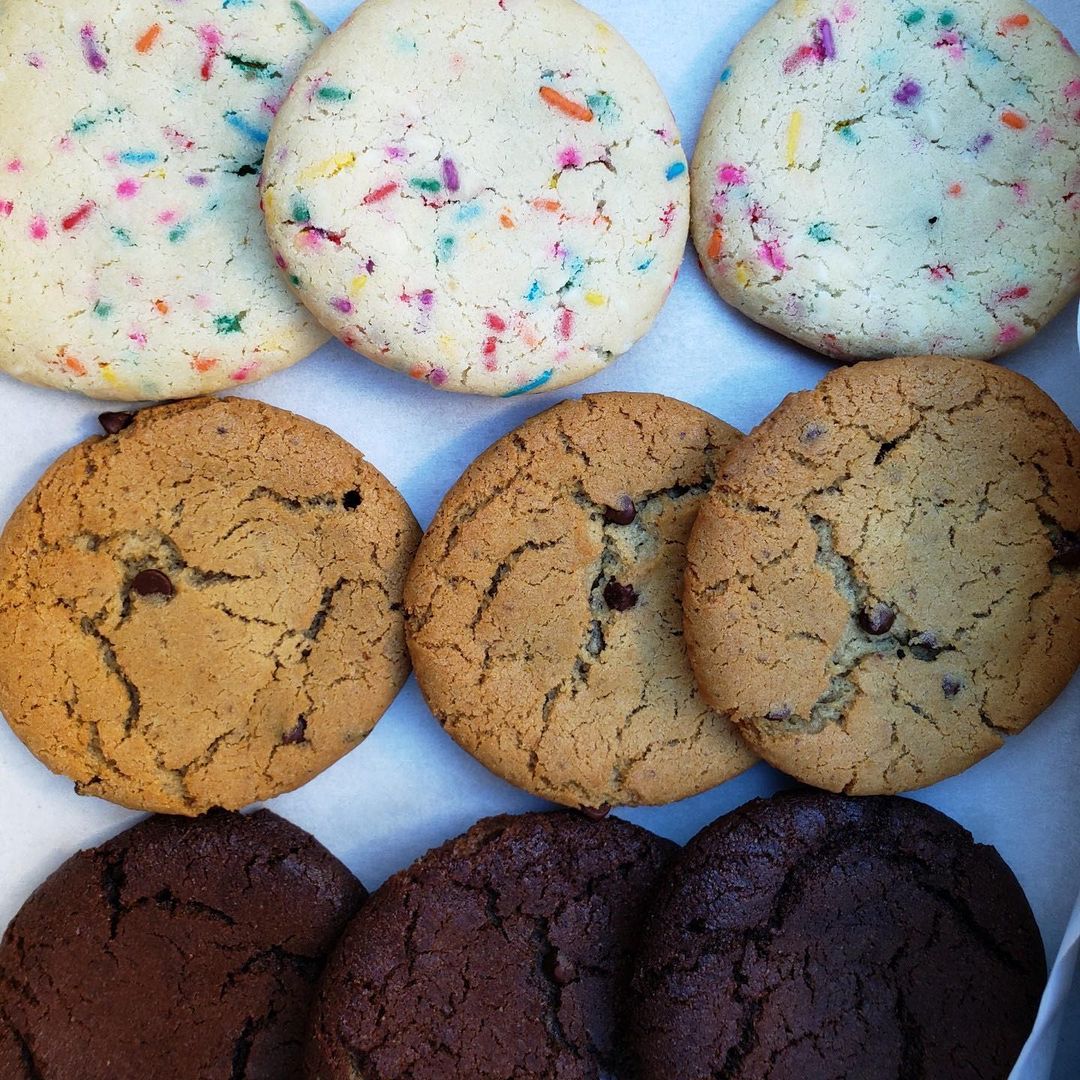 Southern Roots
Southern Roots
This San Antonio, TX-based online bakery recreates Southern classics with a vegan twist—from bundt cakes and brownies to buttermilk pancake mixes. Husband-and-wife team Marcus and Cara Pitts launched the bakery in 2018 after watching the documentary What the Health, which inspired them to go vegan.
Shop here
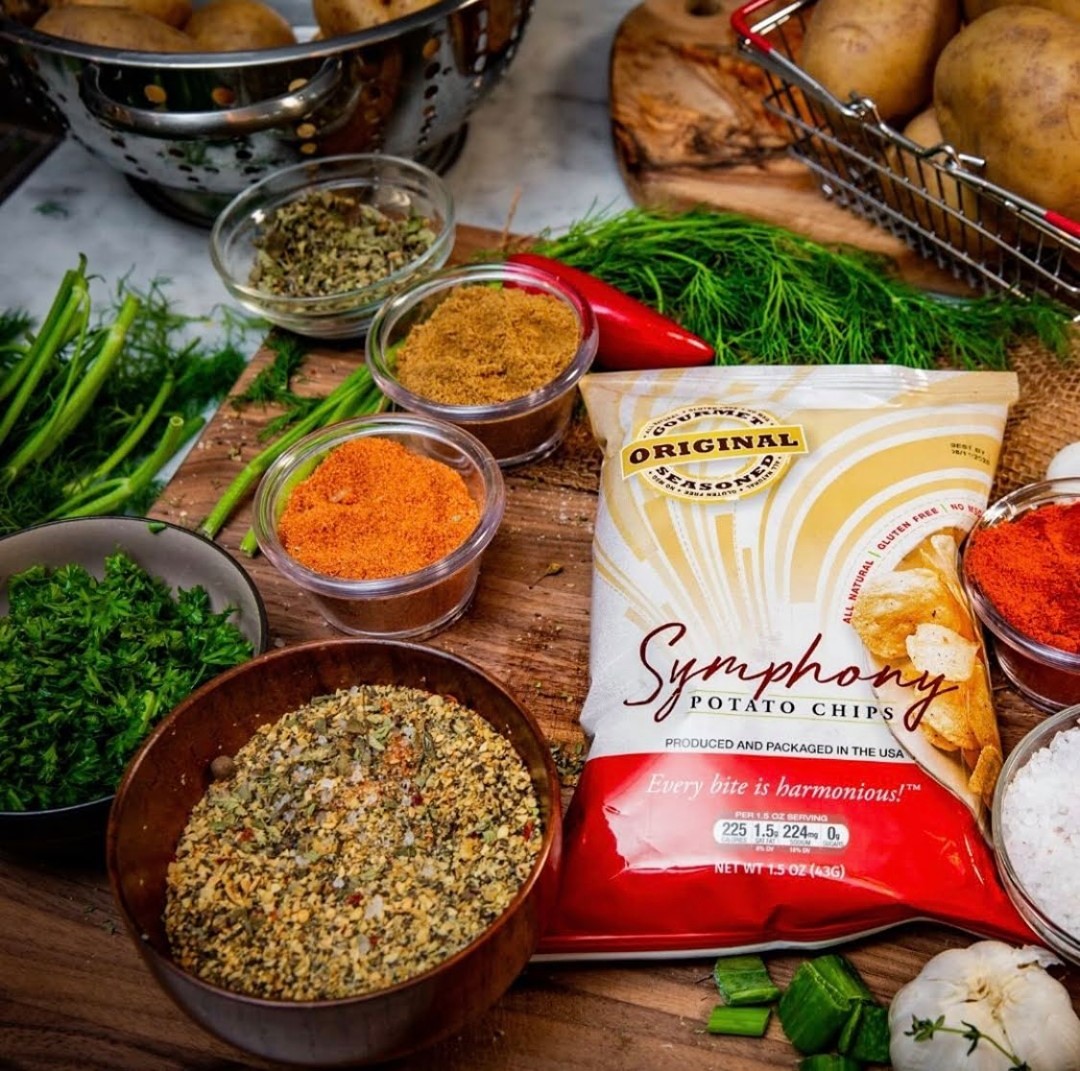 Symphony Potato Chips
Symphony Potato Chips
A gourmet potato chip company, Symphony Potato Chips was born after chef and founder Andre’ Anderson created a 28-herb-and-spice blend and began using it on homemade potato chips. Since then, the brand has expanded to other flavored chips, from balsamic to smoked. The family-owned company also aims to empower its community by providing employment and employment training through their own nonprofit, Symphony Crumbs.
Shop here
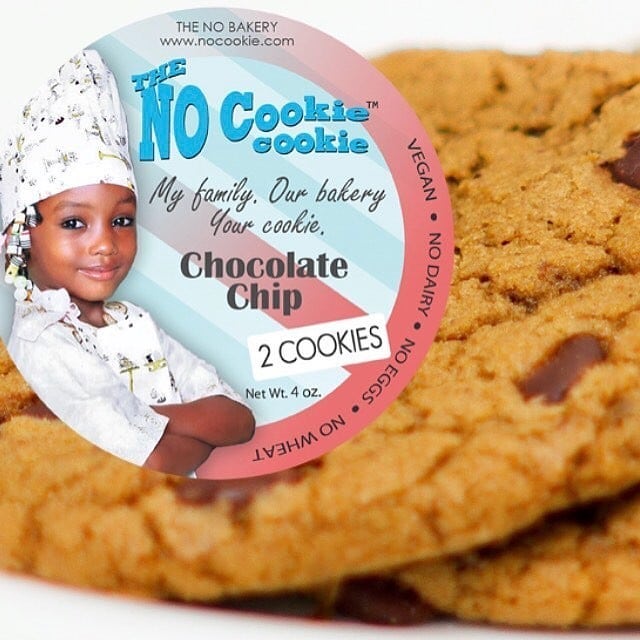 The No Cookie
The No Cookie
Family owned and operated since 1978, The No Bakery creates and sells vegan cookies in classic flavors such as chocolate chip, ginger spice, oatmeal raisin, and peanut butter. Operating from Oakland, CA, the No Cookies are available in more than 400 health and natural food stores nationwide and can also be ordered online.
Shop here
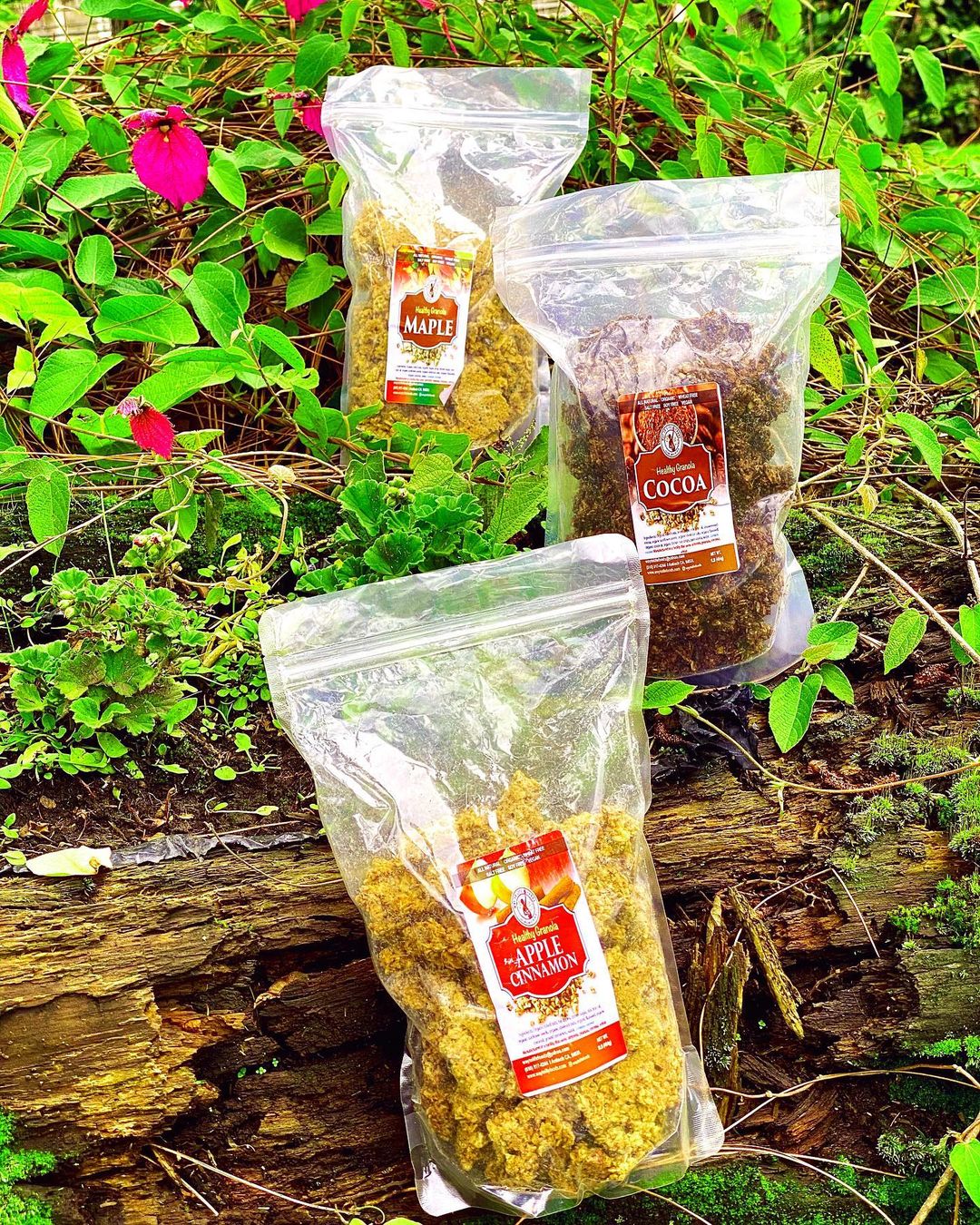 Way to Life Foods
Way to Life Foods
This family-owned vegan food company aims to provide healthful products for its customers across the country. Though Way to Life Foods started with granola—which is available in flavors such as Banana, Strawberry, Ginger, and Peanut Butter—it has since expanded to cinnamon rolls, energy bars, and even vegan burger patties.
Shop here
For more Black-owned vegan businesses, read:
The VegNews Guide to Vegan Black-Owned Businesses
Glow up With These 11 Black Woman-Owned Vegan Beauty Brands
These 25 Black-Owned Vegan Restaurants Are Redefining Vegan Food
This post was originally published on VegNews.com.
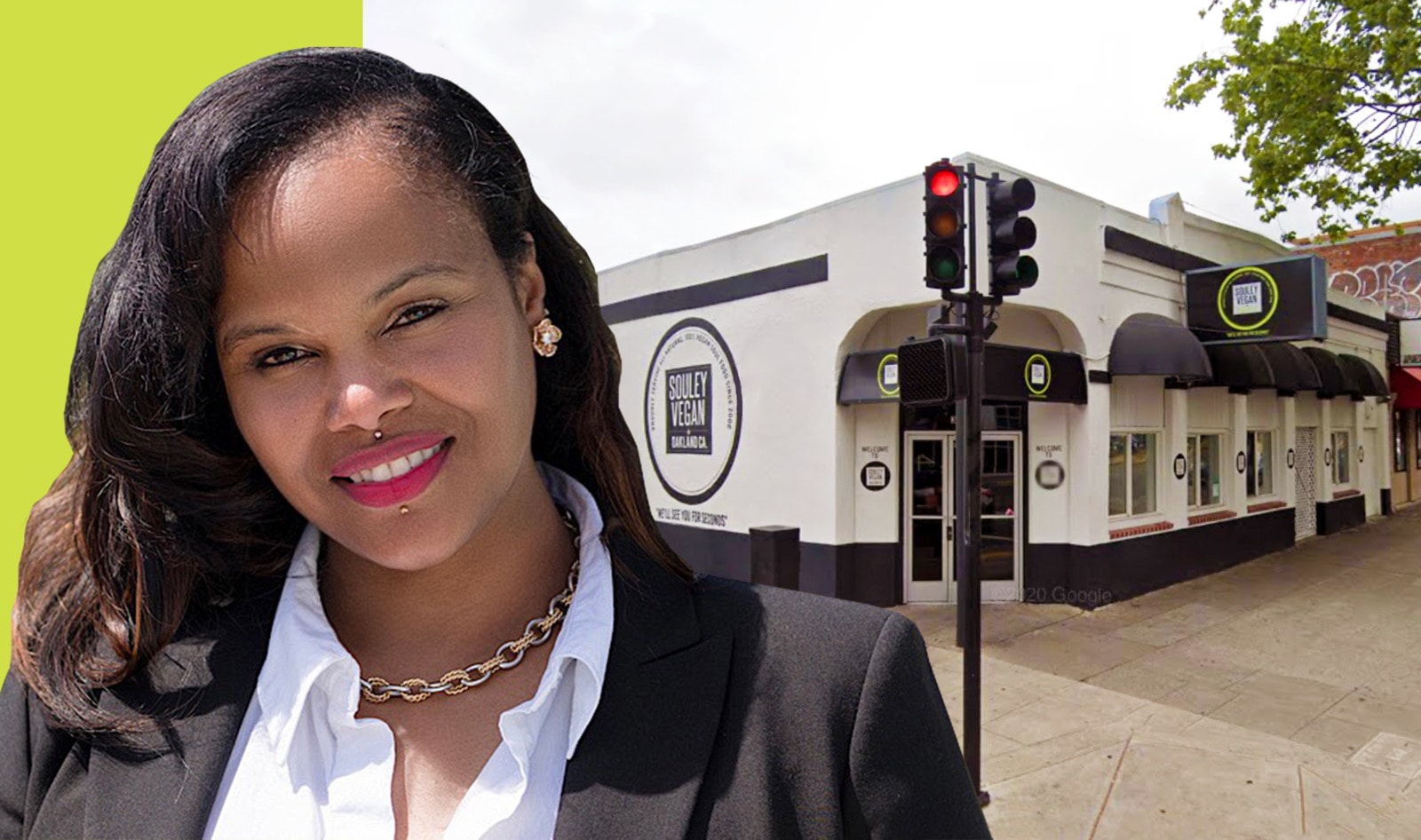
It’s been nearly two years since we started social distancing, staying home to make mountains of sourdough, Korean whipped coffees, and focaccia bread art. But for all the at-home deliciousness we’ve mastered, we’re ready for our favorite restaurants! So although travel is still off the table, we’re celebrating with a mouthwatering tour of the stories—and recipes—from some of the best-loved, Black-owned vegan restaurants in America. From soul food in Detroit to Ethiopian eats in Brooklyn to a soul food empire in Oakland, get ready, because it’s time to eat.
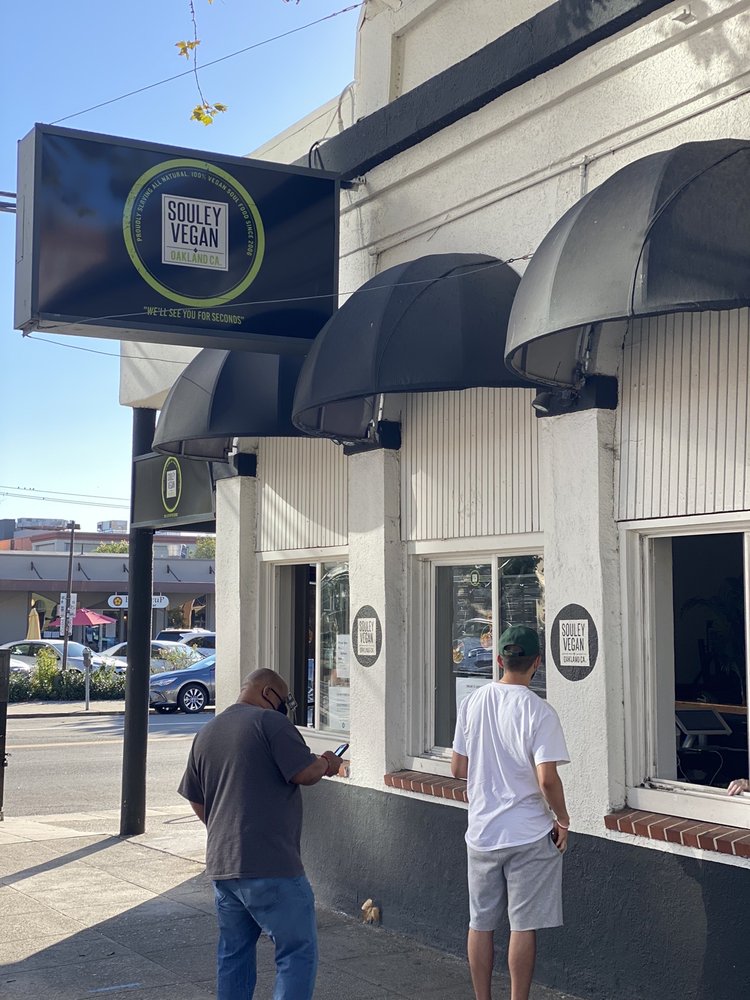 Kimmy 5
Kimmy 5
Running and sustaining a restaurant is already cutthroat enough, with most independently owned eateries closing in the first five years. But somehow, even with just $27 in the cash register and zero savings, single mother Tamearra Dyson was undeterred when she left her studies as a nursing student and opened the doors of what would quickly become Souley Vegan, one of the premier vegan soul food restaurants in the country. More than a decade later, it’s clear Dyson made the right decision—her Louisiana-inspired recipes have drawn customers and accolades, even nabbing a spot as one of the only vegan restaurants featured on Food Network’s Diners, Drive-Ins, and Dives.
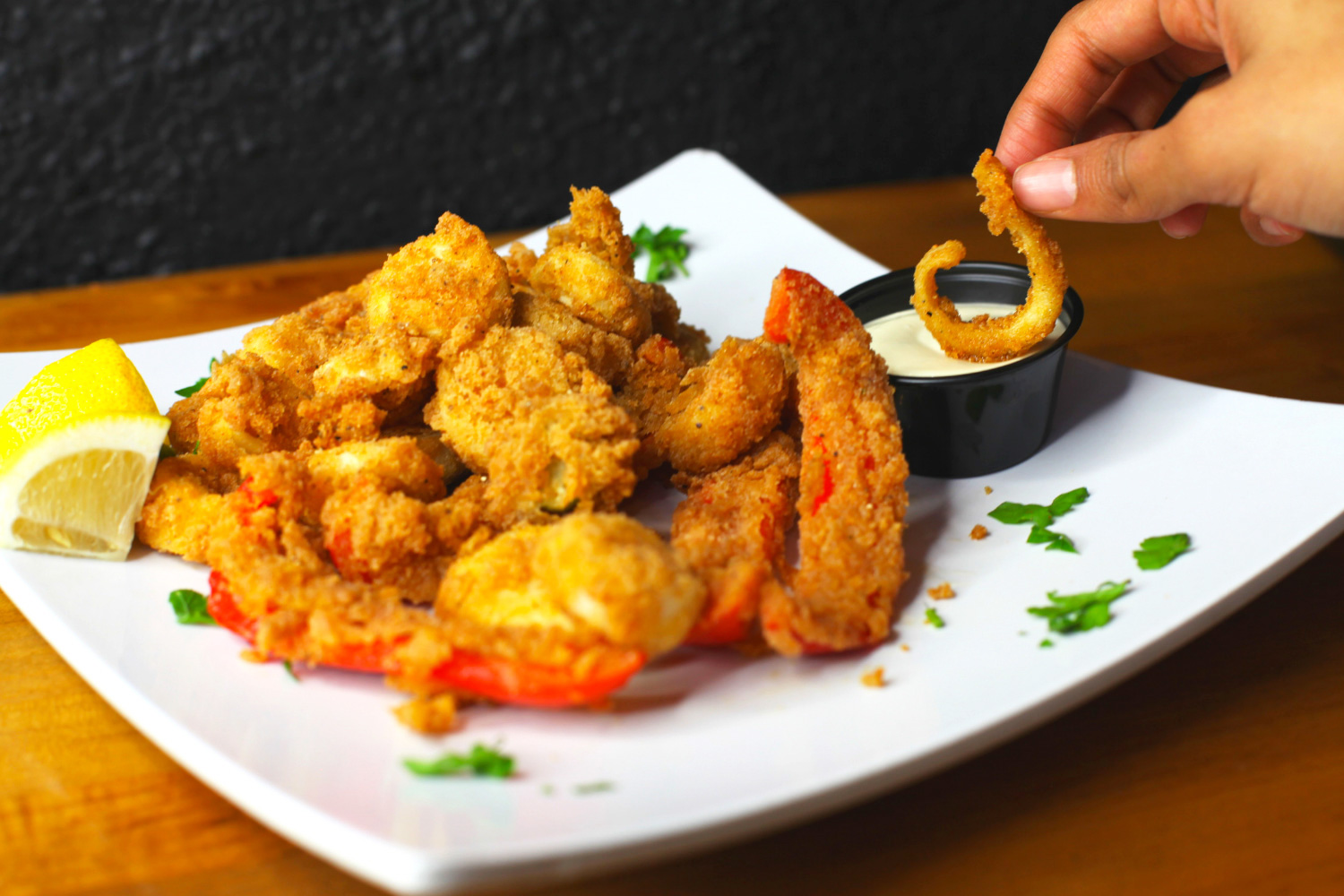 Souley Vegan
Souley Vegan
There’s a reason why Dyson’s restaurant has been named one of the top 10 soul food restaurants in the country. Her Southern Staples Bowl warms customers on chilly Bay Area nights with steaming-hot creamy grits, breaded-and-fried tofu, and a heavy scoop of okra gumbo. For some fire, opt for the Deez Ain’t Gator Bites, featuring diced Louisiana Hot Links, Creole-spiced battered mushrooms, and housemade “swamp sauce”—a tangy, mustardy barbecue sauce (don’t be afraid to add a few glugs of hot sauce, too). But perhaps its most popular dish? The Soul Food Platter combo plate with juicy Southern fried tofu, expertly cooked red boy beans and rice, and silky cashew mac and cheese.
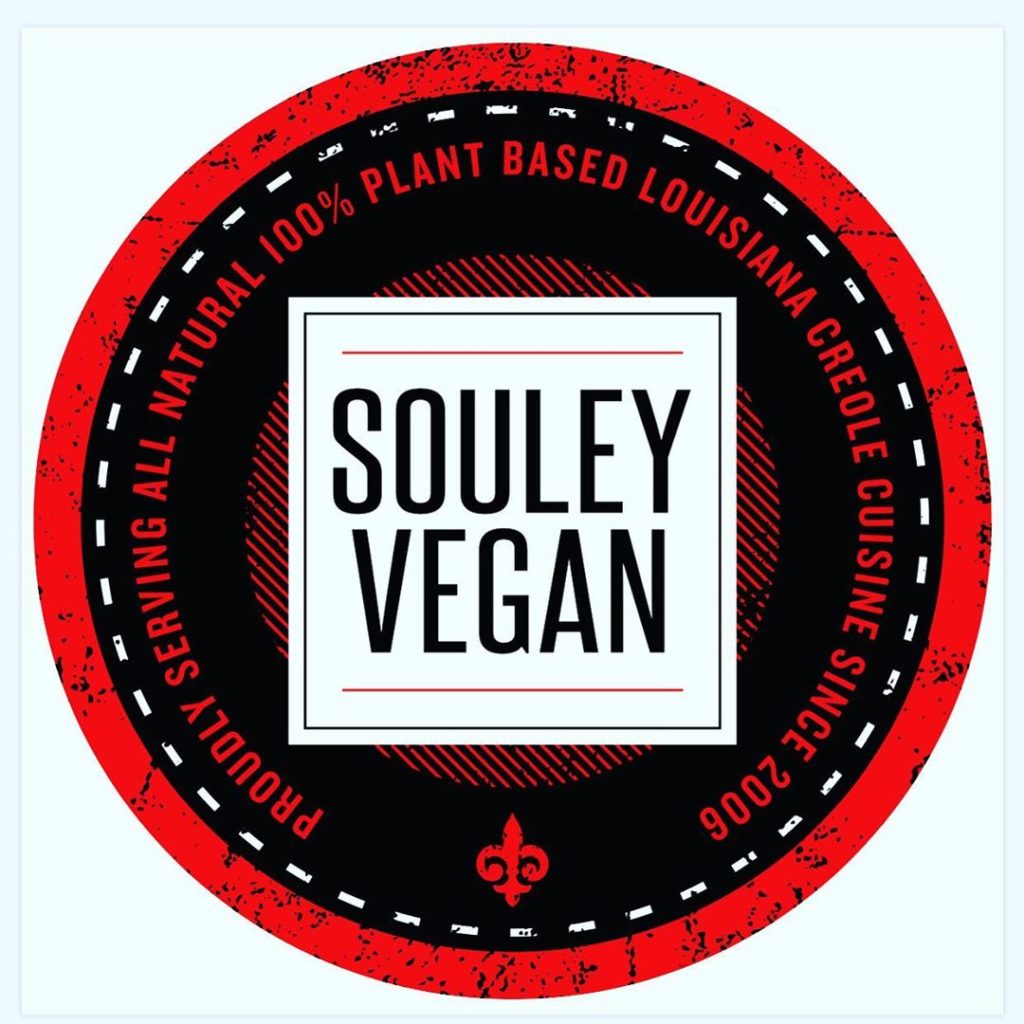 Souley Vegan
Souley Vegan
In 2020, when more than 100,000 restaurants nationwide succumbed to COVID-19, Dyson’s tenacity kicked into high gear. She decided to expand Souley Vegan through a new takeout and delivery-only model, first in Los Angeles and followed by more Bay Area outposts in San Francisco and Oakland. And in a time when comfort was needed the most, the new Souley Vegan ghost kitchens—a model Dyson believes is the future of the restaurant industry—allow customers to indulge in soulful cooking from the safety of their own homes.
Read the entire Great American Black Vegan Restaurant Tour feature in the Black Vegan Issue of VegNews!
For more Black-Owned vegan restaurants, read:
The Best Crab Cakes in Baltimore Are Vegan
This Couple Is Serving Up Vegan Comfort Food in America’s Dairyland
This Restaurant Opened 2 Weeks Before the Pandemic and They’re Booming.
This post was originally published on VegNews.com.
Donald Trump is aiming to take back the majority in the Senate and the House in November, aided by voter suppression, as stage one of his 2024 presidential re-election campaign, write Barry Sheppard and Malik Miah.
This post was originally published on Green Left.
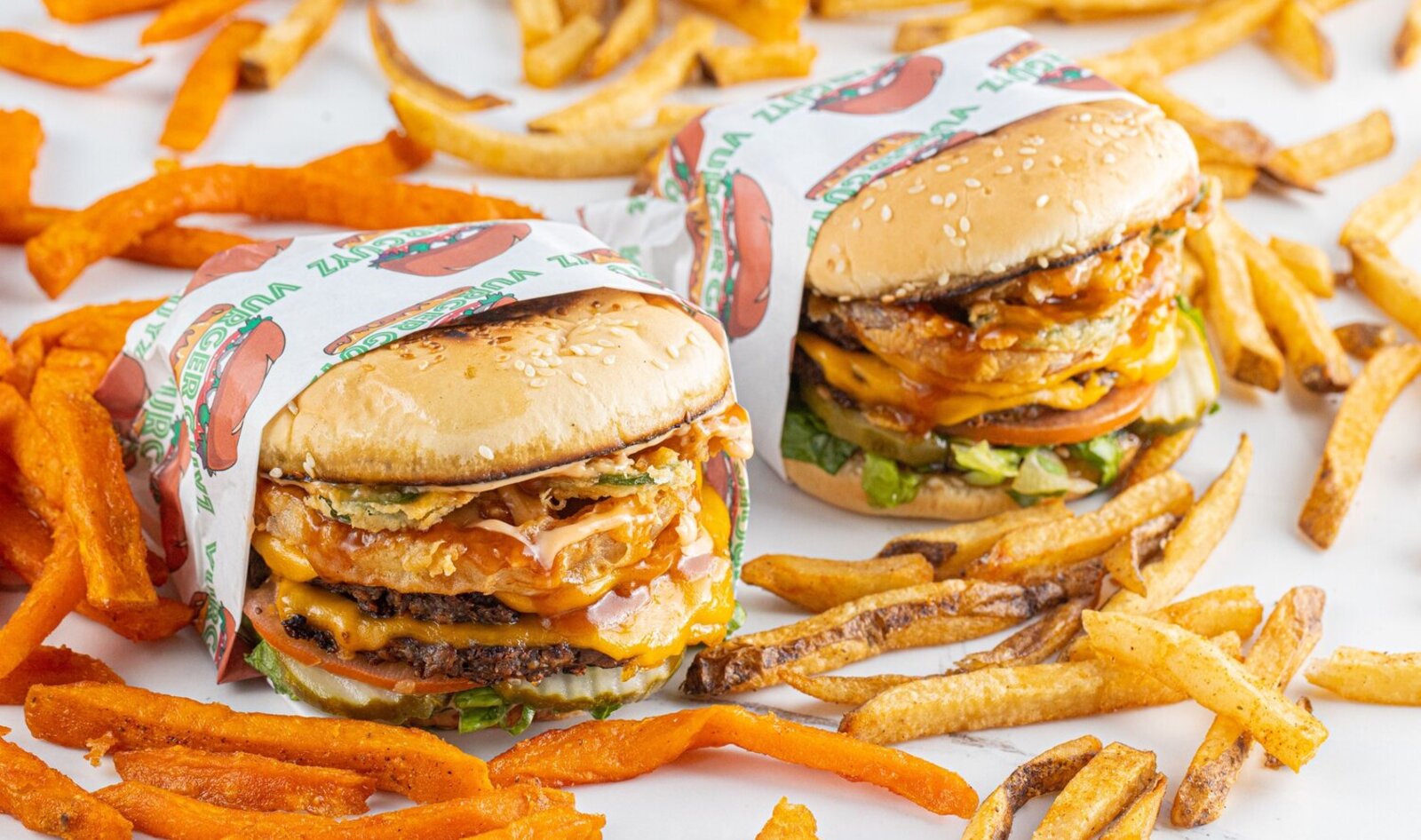
It’s been nearly two years since we started social distancing, staying home to make mountains of sourdough, Korean whipped coffees, and focaccia bread art. But for all the at-home deliciousness we’ve mastered, we’re ready for our favorite restaurants! So although travel is still off the table, we’re celebrating with a mouthwatering tour of the stories—and recipes—from some of the best-loved, Black-owned vegan restaurants in America. From soul food in Detroit to Ethiopian eats in Brooklyn to a burger-slinging food truck in Los Angeles, get ready, because it’s time to eat.
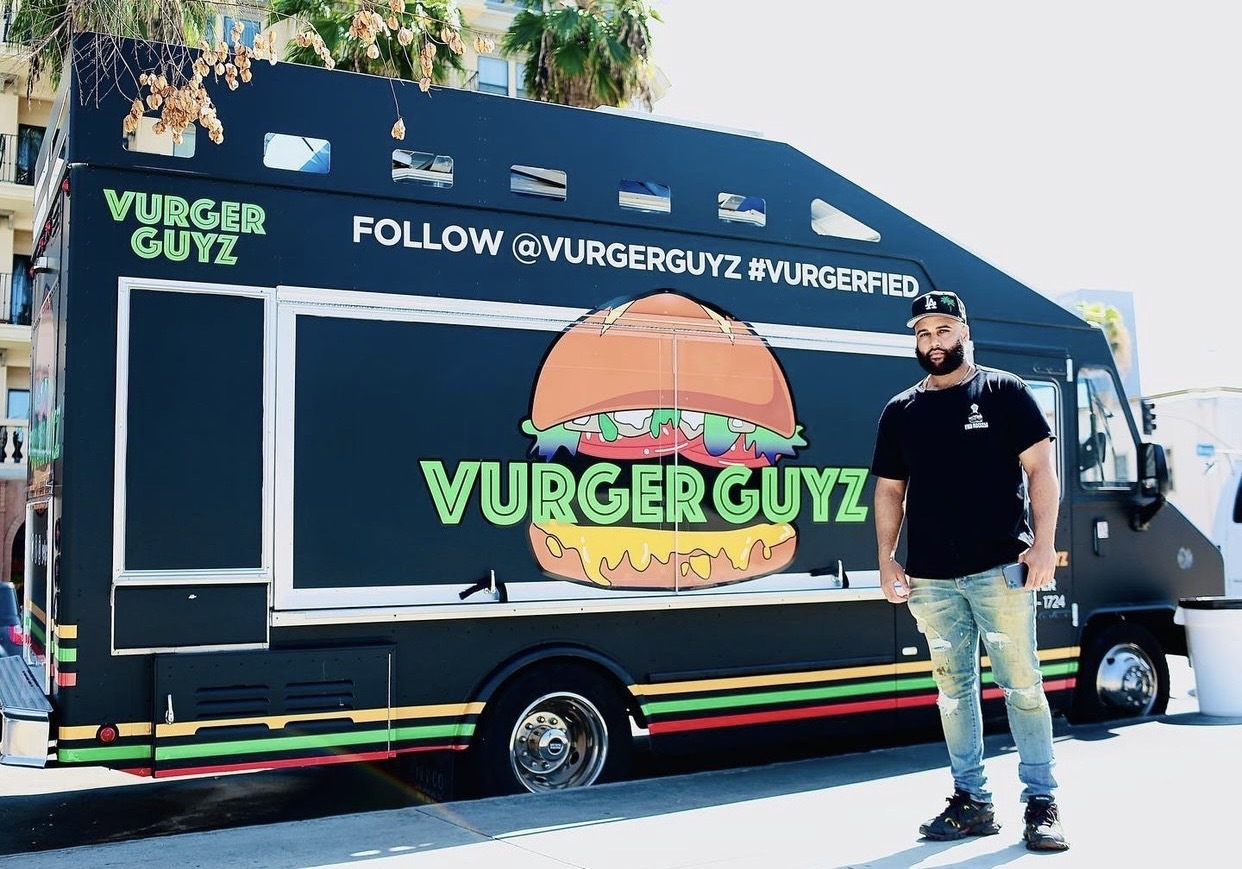 Vurger Guyz
Vurger Guyz
For the past two years, a humble Beyond Burger-slinging food truck has been whizzing across the streets of Los Angeles, leaving many satisfied Angelenos—including a few top-tier celebrities—in its wake. It’s not exactly what creator Naeem Outler envisioned when he started experimenting with meatless burgers after going vegan, but once he cracked the code for the familiar tastes and textures he’d enjoyed in his pre-vegan days, he knew he was on to something. So he and three friends got together, created a menu, and Vurger Guyz was born. For those lucky enough to find the truck parked somewhere in La La Land, juicy burgers, salty-sweet potato fries and tots, and tempting tacos await.
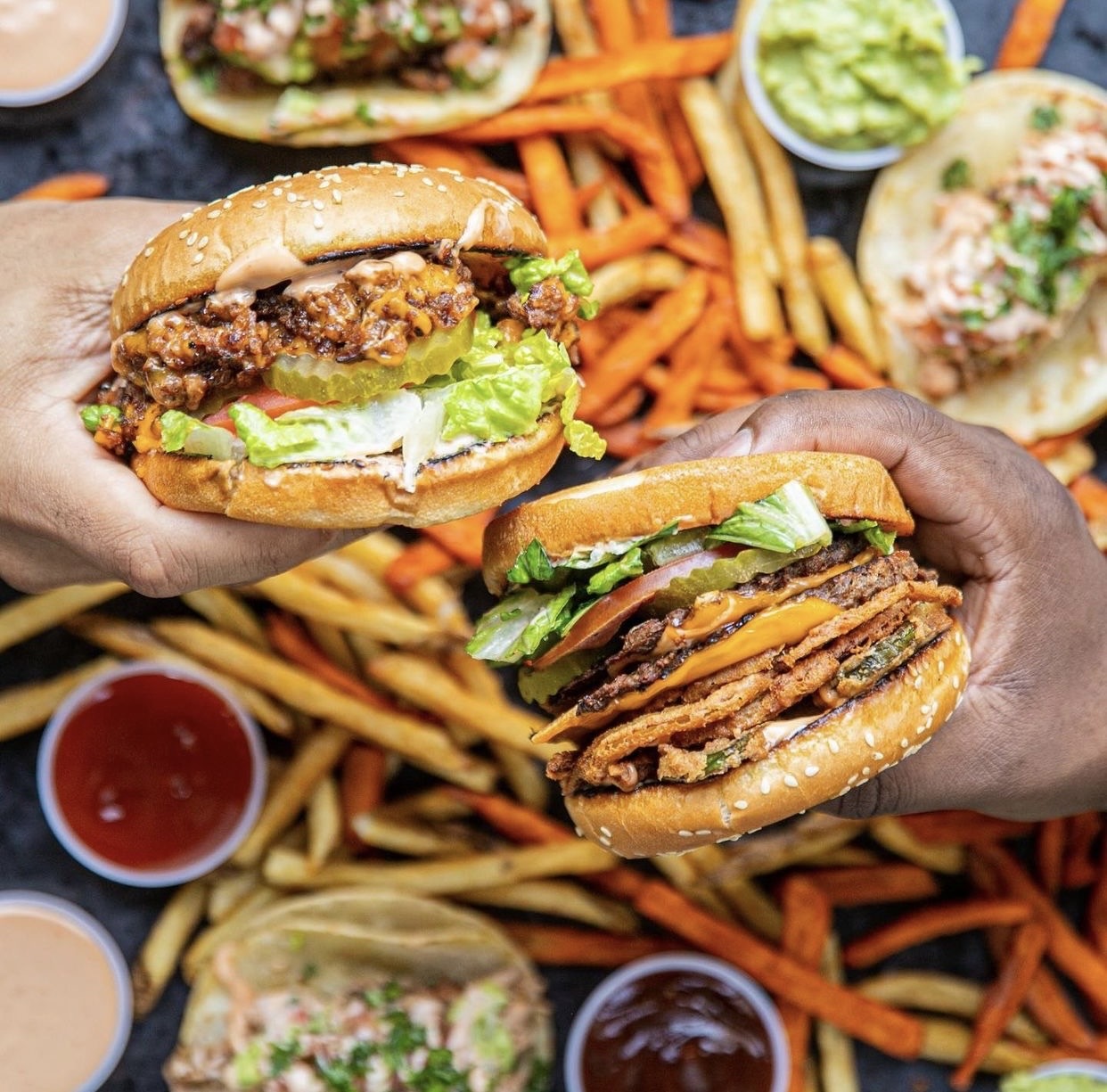 Vurger Guyz
Vurger Guyz
The Guyz let their food speak for itself, evident in their uncomplicated menu of just five burgers, two tacos, and a breakfast bagel. But in a city full of endless vegan options, that’s all this matte black truck needs to attract throngs of vegan and non-vegan urbanites alike. The Classic Vurger features a grilled Beyond patty stacked with caramelized onions, tangy pickles, American cheese, and a top-secret chipotle mayo-style Vurger sauce. Next, a trio of burgers—the Sunrise, Sunset, and Sunburn—adds golden fried onions and jalapeños to the mix. The Sunrise gets more spicy Vurger sauce while the Sunset and Sunburn are drizzled in sticky-sweet barbecue sauce. The Sunburn is seasoned with a secret seasoning mix for an even more next-level experience. Finally, the Philadelphia-inspired Cheesesteak offers a new take on a beloved classic. Plus, Beyond Meat and carnitas-style jackfruit tacos ensure no one goes hungry on Taco Tuesday.
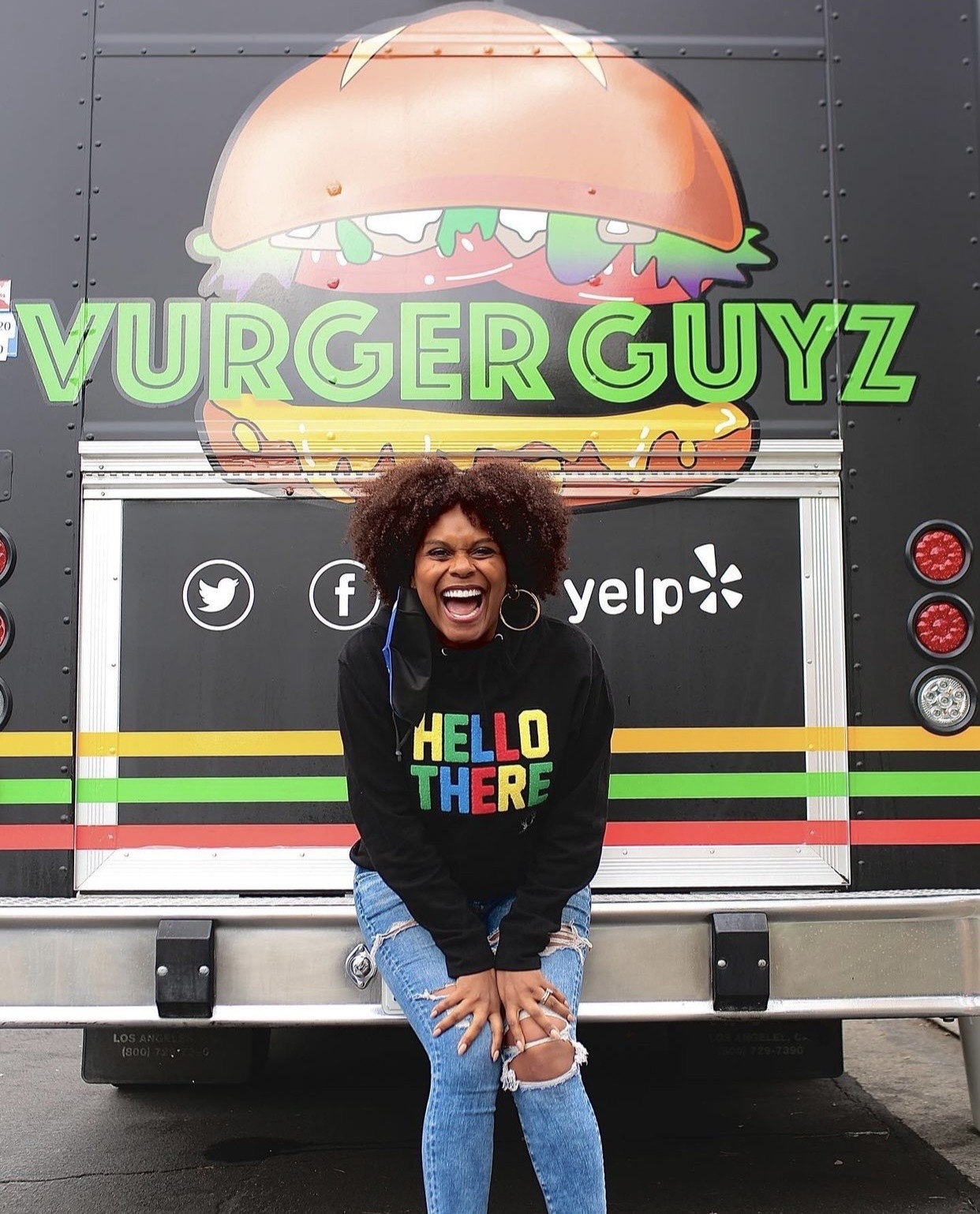 Vurger Guyz
Vurger Guyz
One scroll through the burger joint’s Instagram, and you’ll see support from countless A-listers, such as Grammy Award-winning artist and producer Pharrell Williams, NBA athletes Chris Paul and DeAndre Jordan, singer-actress Christina Milian, and iconic West Coast rapper Snoop Dogg, all eager to get #Vurgerfied. “I didn’t even know it wasn’t the real deal. Actually tastes better than the real deal ‘cause I’ll be feeling a lot better tomorrow,” Snoop Dogg raves. And the Guyz have garnered praise from Beyoncé herself, making it on to Queen Bey’s curated directory of Black-owned businesses last year.
Read the entire Great American Black Vegan Restaurant Tour feature in the Black Vegan Issue of VegNews!
For even more Black-owned vegan businesses, read:How this Mother-and-Son-Run Vegan Restaurant Became a MainstaySisters Close Salon After a Decade to Open Booming Vegan Business
Atlanta’s First Vegan Taqueria Is Woman-Owned (And Amazing)
This post was originally published on VegNews.com.
The jury is currently considering its verdict in the trial of four of the people who toppled a statue of slave trader Edward Colston. On 4 January, Bristol Crown Court heard closing speeches from the defence and the prosecution.
The pulling down of the statue happened during Bristol’s huge Black Lives Matter demonstration on 7 June 2020.
The trial of the Sage Willoughby, Rhian Graham, Milo Ponsford, and Jake Skuse – dubbed the ‘Colston Four’ – has been ongoing since last December, and 4 January was the first day back in court after a break for Christmas and New Year.
Blinne Ní Ghrálaigh – the defence barrister for Rhian Graham – told the jury in her closing speech that Colston was responsible for the enslavement of 84,000 Black people – including 12,000 children – and the deaths of 19,000 people. She said that a:
line in the sand was drawn on 7 June 2020 by those who joined together to pull the statue down and to dump it in the harbour. They recognised the need to make clear that Colston’s victims, those 84,000 Black lives – more than three times the total number of the Black community in Bristol today – that they mattered. That those Black lives matter. That they will not be forgotten or airbrushed out of history. That their descendants’ pain will not be ignored. That their slaver – their tormenter – will not continue to have his crimes whitewashed, as he towers above them on his pedestal.
She said that those enslaved by Colston were:
torn from their homes and families; chained; whipped; branded with a red hot iron with the initials of his company; and shipped across the sea as things – not as human beings – on a journey of horror
She continued:
You heard about the slave ships… You’ve heard about the chilling term “wastage”. You heard about the rapes and beatings. You heard… about it taking seven years to literally work an enslaved person to death.
Raj Chada – defence counsel for Jake Skuse – said to the jury:
The statue of Edward Colston, standing in the centre of Bristol, [was] utterly indecent, offensive and disgraceful. We all know that.
The Bristol demonstration was part of the global Black Lives Matter movement that came in the wake of the killing of George Floyd by Minneapolis police.
Ní Ghrálaigh told the jury:
On 25 May 2020 shortly after 8:20 pm, African American George Floyd was murdered by police officer Derek Chauvin, who knelt on his neck for 8 minutes and 46 seconds until he stopped breathing. The video of his long drawn out killing went viral around the world. People heard his repeated pleas of “I can’t breathe” and his desperate cry to his dead mother
People in Bristol were quick to join the movement. On 7 June, 10,000 people gathered on College Green for the biggest in a series of powerful Black Lives Matter demonstrations. Tiffany Lyare – one of the demonstrators – told Vogue Magazine at the time:
I didn’t want to protest just because of the loss of George Floyd’s life, but because of the fact that I am also black and I have experienced discrimination and racism first hand
Lyare added:
It almost felt like it was a personal attack to myself in a way
As the marched passed the statue of Edward Colston, people paused and began to work together to remove the statue by putting a rope around its neck and pulling.
The court was reminded that one of the police witnesses earlier in the case had estimated that thousands of people had been involved in taking the statue down. According to Ní Ghrálaigh:
Police Officer Julie Hayward estimated that there were in excess of 3,000 people around the statue, just under a third of her estimated total of at least 10,000 marchers.
These included:
Those people around the statue who joined together spontaneously to pull as one on the rope that Rhian Graham had supplied [and] those people who applauded them as they did.
Ní Ghrálaigh told the court that:
After the slave trader was toppled, and the jubilations were over, a Black man knelt on Edward Colston’s neck for 8 minutes and 46 seconds, the length of George Floyd’s slow murder. The statue was rolled to the harbour and unceremoniously dumped in the water.
Chada told the jury that Jake Skuse was one of the people who helped drag the statue across the cobblestones to the harbour. According to Chada, the cobblestones were:
cobbles which in his mind signified where people would have been dragged unwillingly in centuries before, dragged to the harbour in the symbolic act of being dumped there.
After the toppling of Colston, hundreds of messages of support were left at the foot of the – now empty – plinth. Some of them read:
I want to send my gratitude to the people who participated in the toppling of the Colston statue. It was never an erasing of culture but creating a better informed history…
Power to the people. Equality is Quality.
and:
At least I won’t have to see that fucking slave trader on my way to work anymore.
The events of 7 June – and the momentum of the global Black Lives Matter movement – led to the renaming of Bristol’s Colston Hall and a decision to rename two schools in Bristol named after the slave trader. The court also heard that a pub in Bristol changed its name; that the stained glass windows and other dedications to Colston had been removed from St Mary Redcliffe Church and Bristol Cathedral, and that Colston Tower has been renamed Beacon Tower. The Colston Society also voted to close itself down.
The court heard that the toppling of the statue of Colston had been celebrated in Trinidad and had been mentioned during the funeral of George Floyd in the US. Ní Ghrálaigh told the jury:
Gloria Daniel, the great, great granddaughter of the enslaved child John Isaac, emphasised the significance of the toppling. She said that it served as a marker that “we had finally arrived at a place in history where people would no longer tolerate the continuing dehumanisation of Black people”.
Despite the massive public support for the toppling of the statue, Avon & Somerset Police – egged on by Priti Patel – made a series of arrests and eventually charged the four people who are in court with criminal damage. The Glad Colston’s Gone campaign commented at the time:
Hundreds can clearly be seen on camera to have been involved in various activities that led to this object being pushed into the harbour. Despite this, authorities have decided to single out four people
In response to the statue toppling, the Tory government’s controversial Police, Crime, Sentencing and Courts Bill is proposing a new offence of damaging national monuments, which would make actions like the one against the Colston statue punishable by up to ten years imprisonment.
Tom Wainwright – the defence barrister for Milo Ponsford – likened the removal of the statue to removing a cancer:
If you have a cancer like Colston festering in your city, you cut it out. Even a new plaque would only have been a sticking plaster. Cutting it out will leave a scar, so that people remember what was there in the past and make sure it doesn’t return, but only once it is gone can the body heal. You have heard during this trial of the positive impact this action had, in prompting action where there was lethargy, promoting understanding where there was ignorance, provoking discussion where there was silence. Not just in this city, not just in this country but around the world. Bristol, like its tower, is no longer weighed down by the name of Colston but is a beacon showing how to bring communities together.
Stephen Clarke – who is an ex-lawyer observing the trial – tweeted:
Colston 4 trial: summing up for Milo Ponsford. Talking about bristol bus boycott and other movements in Bristol. Pulling down statue is part of that chronology: ‘correcting the record is not vandalism it is progress’@CounterColston
— Stephen Clarke (@southvillesteve) January 4, 2022
Clarke tweeted this about defence barrister Liam Walker’s closing speech on behalf of Sage Willoughby:
Colston 4 trial. Sage Willoughby summing up.’Edward Colston advocated murder of children: there has been a deliberate policy not to educate us on Britains role in the slave trade. Be on the right side of history. This judgement will reverberate around the world’. @CounterColston
— Stephen Clarke (@southvillesteve) January 4, 2022
The court heard that the statue was erected almost two centuries after Colston’s death, due primarily to the efforts and funds of James Arrowsmith. Ní Ghrálaigh told the court that Arrowsmith was part of the Society of Merchant Venturers
This was the same society that Colston had been part of, and which had been instrumental in pushing forward centuries of white supremacy, enslavement, and colonisation.
Ní Ghrálaigh explained the context of the memorialisation of the erection of the Colston statue in 1880:
As you have heard, the statue of Colston was erected 170 years after Colston’s death. That was nearly 90 years after the slave trade had finally been outlawed in Britain.The statue celebrated someone from the distant past whom James Arrowsmith knew had made his fortune from slavery. Some historians… believe that
it was erected in direct response to the statue that went up the previous year to Edmund Burke, an opponent of the slave trade.The statue would not just have been a whitewash of Colston’s role in the slave trade. If those historians are right, it would have been a deliberate defence of the trade, at a time when the depravity of treating human beings as things had long been laid bare
The judge in the case reminded the jury of the evidence of Jonathan Finch, head of Culture and Creative Industries for Bristol Council, who told the court under cross-examination from the defence that “concerns had been raised” about the statue at least as far back as the early twentieth century, and that campaigns had been calling for its removal since at least the 1990s.
The jury was reminded that Finch admitted that people felt “very strongly” about it.
But Chada told the jury that the council had done nothing about these community concerns:
Despite knowing about all about its offensive nature, the statue was displayed for over 100 years. And the Council did nothing. They achieved absolutely nothing but over 100 years of inaction.
Ní Ghrálaigh and Chada told the jury that – after years of public pressure – the council had considered correcting the plaque, which extolled the virtue of Colston. However, the correction was thwarted when the Society of Merchant Venturers intervened.
Ní Ghrálaigh pointed out that Cleo Lake – former lord mayor of Bristol – and said it “embarrassing” that the defendants “were in the dock for doing something that many democrats in the City believed should have been done decades ago“.
Both Chada and Ní Ghrálaigh invited the jury to ask themselves why the council were appearing as witnesses for the prosecution for the pulling down of the statue. According to Ní Ghrálaigh:
Indeed, members of the Jury, you might think what on earth is the council doing giving evidence to support a conviction in this case, having itself so abjectly failed to deal with the statue for so many decades?
The defence argued that the four defendants had a lawful excuse for the toppling of Colston.
According to Ní Ghrálaigh
Rhian Graham, and the many others who pulled down the statue recognised the need to say: this is not Bristol. A slave trader is not Bristol. We will not continue to dress up a devil in angels’ robes.
Bristol Radical History Group has published a collection of statements by Bristolians in support of the Colston topplers. You can read the full document here, but we thought it would be appropriate to end this piece by publishing one of them – written by a Black Bristolian.
This statement is by Ros Martin – a local artist – who was arrested in January 2021 for attending a protest in support of the Colston topplers. Martin’s arrest and prolonged detention was condemned as another example of racist and discriminatory policing. She made the following statement at the time in support of the Colston Four:
We take control of colonisation and slavery’s transatlantic narrative and legacies in our city through our actions of repair, reflection, remembrance the calling forth and honouring of African ancestors, whose blood and brutalised lives in plantation in the Caribbean and Americas built up the wealth of this city.
Linking past and present we can vision a better future, one in which we move from being mere bystanders to calling out and actioning a more just Bristol for all.
The toppling of the Colston statue… is the unfinished business of a now discredited memory of slavery in the city tainted in monuments to the so called ‘great and good of the city’, epitomising all that is self–serving and disingenuous about the wielding of power, not just in the past but currently in our midst.
Thank you for pulling down the statue, such a burden lifted. Onwards in struggle
Featured image via Youtube
By Tom Anderson
This post was originally published on The Canary.
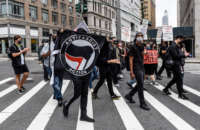
The past four years have seen terms like “antifa” hit common parlance around the U.S., but have also seen confusing distortions of what that term means. As right-wing pundits work desperately to paint any and all potentially left-leaning protest action as anti-fascist, and then reframe anti-fascism as a series of nefarious terrorist plots, this has shifted much of the climate toward suspicion of anti-fascist activists. Despite the violence related to 2020’s protests being largely from far right vigilantes and the police, the mythology of “antifa violence” has still been spurred on by rumors, conspiracy theories and dubious allegations. This has provided cover to the far right, which uses claims of “community safety” to head into cities and attack anti-fascist protesters, as has been seen in a sequence of confrontations between far right and anti-fascist demonstrators in places like Portland, Oregon. This perception, along with attempts to crack down on activists through state repression, have led to what many people have alleged are excessive sentences that were disproportionate to the charges being faced.
In cases around the country, such as David Campbell in New York City, activists were facing prison terms for what they have claimed are self-defense against violence by far right groups, such as the Proud Boys. For many activists who have made it their job to try and prevent far right groups from parading into marginalized communities, threatening further attacks, they are finding that prosecutors’ offices see them as the antagonist in the situation.
This is what happened to Alexander Dial, a Portland, Oregon, resident who faced a series of serious felonies after a confrontation at an August 19, 2019, anti-fascist demonstration. Dial came to national prominence after photos surfaced of him taking a hammer away from a member of the fascist group the American Guard, which the Anti-Defamation League refers to as “hardcore white supremacists,” amidst what people on the scene referred to as an attack. Dial was wearing a mask and a shirt that said “Beta Cuck 4 Lyfe,” a play on the insult that far right internet trolls try to use to demean leftist men.
Dial said that he has attended protests most of his adult life, and had attended the August 17 event to show his support for the anti-fascists being targeted. The event was organized by the anti-fascist group Pop Mob and a coalition of other leftist and progressive organizations in response to a planned Proud Boys rally. The Proud Boys planned their event after another protest, just a few weeks earlier, where Pop Mob had created a dance party in response to another pair of planned far right demonstrations, one by the Proud Boys and the other by affiliates of a local far right group, Patriot Prayer. The dance party was named the “milkshake” after the then-recent “milkshaking” of English Defence League founder Tommy Robinson, known for agitating Islamophobic hatred in Britain, where activists threw milkshakes on him to humiliate him on camera and ruin his clothes. Far right media figure Andy Ngo had milkshakes thrown on him and was assaulted at that event in a well-publicized incident, which launched him to right-wing celebrity status. The Proud Boys, in response, planned a rally “against domestic terrorism,” and hundreds were set to descend on Portland.
The event itself was relatively peaceful as Pop Mob orchestrated a carnivalesque atmosphere less than a mile away from the Proud Boys, but in the same waterfront park. Black bloc activists, who dress in head-to-toe black outfits as a protest tactic and often take on more militant approaches, separated the two groups, ensuring that the Proud Boys could not attack those attending the Pop Mob event. Eventually, the police let the Proud Boys take to the bridge that separates the East and West sides of town. The American Guard members, however, allegedly took a bus back over to the Westside, near the anti-fascist demonstration, where they were met by anti-fascists.
“[I thought] those guys are here to cause trouble. Something is going to happen wherever they are,” Dial told Truthout. He then joined with a group of other activists he did not know to try and stand in the way of the American Guard from reaching other demonstrators. “They started to brandish weapons from inside. Knives. A clawhammer. They had guns,” said Dial.
Dial says that when they came out, one of the American Guard members tripped, was approached by someone else, and the Guard member dropped the clawhammer. That is when Dial got ahold of it, swung it to get them away, and threw it at them. The American Guard bus eventually left, and Dial was later circled by multiple police and arrested. It wasn’t until days later that he found out that he was being charged with multiple felony counts, including assault in the second degree and a riot charge. They charged five additional people with riot charges, making a total of six, the number legally necessary in Oregon to charge that an illegal riot had, in fact, taken place. Dial was taken from his arraignment straight to Multnomah County Jail, where he sat for 11 days until his bail was posted.
“The left is seeking progress, and that means changing institutions in ways that better more people. And if you are running the institutions that are capitalizing off of marginalized populations, you are going to fight back with all the powers of the system,” says Dial. “So overcharging anti-fascists is the easiest, cheapest thing to do.”
Dial says that the expanded charges came, in part, from the release of video that was taken on that day by Elijah Schaffer, a media person with the right-wing outlet The Blaze, and was amplified by Andy Ngo (including hosting the video on his YouTube channel). Two of the charges that had come down were what are called Measure 11 crimes, those that carry with them “mandatory minimum” sentences of more than five years. Measure 11 passed in Oregon in the mid-1990s as a way of getting “tough” on violent crime, and one of the cases that was used as an example of the time was when an antiracist skinhead shot and killed a neo-Nazi when defending himself during a New Year’s Eve attack.
Because of the current bail system, and the charges that had been tacked onto his case, Dial’s bail of over half a million dollars meant that he had to put up $54,000 to get out. Fifteen percent of that money, nearly $8,000, is kept by the county permanently, and he had to solicit donations from friends and family to get this money, clearing out his savings and “financially ruining” him. Once he got out, he had to pay to have an ankle monitor on, which he wore for months, as well as observing a curfew. Because his court case was extended for over two years, he had to get by on severely limited pretrial release conditions. His ability to work was hindered and he relied on many of these anti-fascist organizations to provide a great deal of support.
“[We] knew that what he needed most was a good criminal defense lawyer,” says “Walter,” an administrator of the International Anti-Fascist Defense Fund, which raises money for anti-fascist activists facing legal or medical costs. (Walter is using a pseudonym for fear of retaliation for their activism.) “All mutual aid in anti-fascism is important, but we believe the Defense Fund fills a gap by ensuring that anti-fascists who run into trouble don’t ever feel like they only have themselves to rely on.”
Support came internationally, with donations from across the world and thousands of people signing a petition demanding the charges against Dial be dropped.
Dial eventually took a plea agreement, and then in November of 2021, he had all but two charges dismissed by the judge, and he was given “time served,” three years of probation and 80 hours of community service, which Dial says he will try to complete by working with a nonprofit that helps upgrade the homes of people with disabilities to make them more accessible.
“No matter what you’re choosing to organize or whatever actions you want to take, [you need to] develop and maintain strong community ties with people you trust,” says Dial, who points out that this means real-world relationships and not just virtual ones mediated through social media. “You need connections with people who have your back and who know how to reach out to other people who might be able to help you in ways they can’t. What got me through all of this … was my community.”
These are the types of bonds that many anti-fascist groups are creating, and what can sustain many activists when targeted by state agencies. Community organizing is built on these bonds, and as was seen during the 2020 Black Lives Matter demonstrations, mutual aid and fundraising support was a key part of sustaining the organizing itself. Without those levels of support for individual activists and long-term solidarity organizing, state repression could have a chilling effect on other organizers by making it appear too costly and dangerous.
The International Anti-Fascist Defense Fund addresses those needs by raising money and disseminating it where needed. Since 2017, the fund has disseminated over $19,000 to a total of 15 recipients who have faced financial hardship from their activism or have been targeted by the far right, according to Walter.
“[We] all recognize that standing up to bigotry [and] fascism is dangerous but necessary work, which is why it is important for everyone to stand behind anti-fascists when they run into trouble,” says Walter. “We believe that this is real solidarity and is true to the saying, ‘We keep us safe!’”
Dial’s story shows that it is these community connections that get activists through these situations, which may become more necessary as leftist protesters deal with the fallout from intense policing practices during the 2020 protests. By connecting different movements through bonds of resource solidarity, social movements become sustainable and individuals can come through these challenges with enough stability to continue.
Dial says that he is going to work to repeal Measure 11 in Oregon, which has reinforced a carceral culture that has been used disproportionately against marginalized communities. By sharing his story, he wants to give insight to those facing similar challenges about what it takes to survive overcharging by the state.
“You need connections to people who have your back and who know how to reach out to people to help you in ways they can’t,” says Dial. “That’s the whole point of why we’re all doing this in the first place. It’s about community.”
This post was originally published on Latest – Truthout.
An interview with Amitav Ghosh, the author of The Nutmeg’s Curse: Parables for a Planet in Crisis.
This post was originally published on Dissent MagazineDissent Magazine.
“Democracy had well and truly broken down” over the statue of Edward Colston in Bristol, a protester accused of toppling it has said.
The memorial to the 17th century slave trader was ripped down during a Black Lives Matter march in the city centre on 7 June 2020.
It became an iconic moment in the wave of anti-racism protests staged around the world in the aftermath of the killing of George Floyd by a police officer in the US.
Rhian Graham is one of four people on trial at Bristol Crown Court facing a charge of criminal damage.
Giving evidence on Monday, Graham pointed out that there have been campaigns to have the statue of Colston removed from the town centre going back to the 1920s.
Multiple petitions and protests and even support from a Bristol MP had failed to bring about any change, she said.
A plan to affix a new plaque on the statue detailing Colston’s role in the slave trade had petered out when the Society of Merchant Venturers – a local philanthropic organisation – intervened.
The group, which administered much of Colston’s £70,000 legacy to the city after his death, wanted the proposed wording changed to ensure his philanthropy was mentioned before his role in the slave trade.
It also wanted any mention of the trafficking of children removed.

Marvin Rees, Bristol’s Mayor, decided to halt the plan because he disagreed with how far the text on the new plaque had been diluted.
Graham said Colston had “perfected” the slave trade, adding: “No amount of philanthropy excuses you from that amount of hurt and suffering.”
She described the Society of Merchant Venturers as “an undemocratic body of people, wealthy people, who have a lot of power and influence in the city”.
Graham added:
It is that abuse of power that causes so much frustration – the abuse of power and their stepping in and not allowing the truth of history to be told.
She continued:
At that point, what do you do? How long must you ask to be heard and not be listened to?
I believe the council should have done something earlier, I do know that our MP, Thangam Debbonaire (Bristol West) had been calling for it to come down since 2018 and nothing was happening.
I believe democracy had well and truly broken down around that statue.
Graham said that she had signed petitions to have the statue removed, but did not see any point in writing to her MP seeing as Debbonaire had already spoken out about it.
“(The council) had long enough to recognise how much harm a monument to a slave trader does in a very multi-cultural city – it doesn’t take much to realise that harm,” Graham said.
“Over 100 years of dissent – someone should have listened.”
Graham has admitted going to the protest with a rope in her bag, and helping to pull the statue down, but denies the damage done was criminal.
”By removing that statue we were removing a great symbol of oppression that towers over our community and is an offence to so many,” she said.
“That was an act of solidarity and compassion, not violence.”
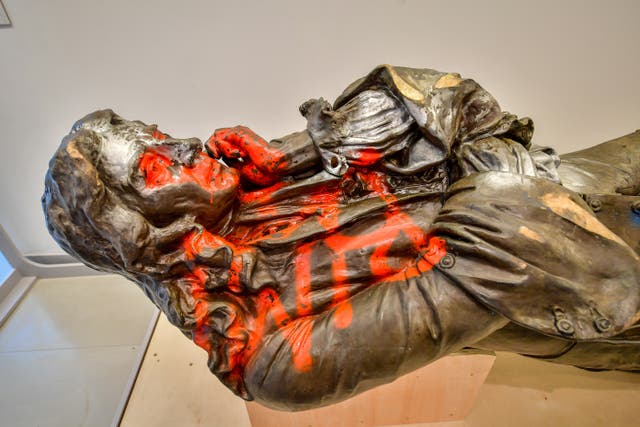
Graham told the court she did not have a background in politics or activism but had become much more aware of racism and inequality after moving to Bristol five years ago.
“From 2019 I started to make more friends who had more of a passion for history, politics and equality,” she said.
“I felt a bit embarrassed about my own knowledge and felt I needed to try and engage more with the world.”
Graham continued:
Having grown up in a predominantly white neighbourhood in Norfolk I experienced a lot of casual racism and homophobia and sexism.
I didn’t think of myself as racist but the more I understood the experience of a black person on a daily basis, I felt I had been a terrible ally and I feel like I could have been more supportive.
The realisation of the privilege I have because of the skin colour I have made me feel like I needed to stand in solidarity for black lives.
The trial, which is due to conclude at the end of this week, continues.
By The Canary
This post was originally published on The Canary.
Donate now to support Reveal’s journalism.
•••
The final episode of Mississippi Goddam shares new revelations that cast doubt on the official story that Billey Joe Johnson accidentally killed himself.
This week marks the 13th anniversary of Johnson’s death. His family is still seeking justice. Our reporting brought up questions that the original investigation never looked into. Host Al Letson and reporter Jonathan Jones go back to Mississippi to interview the key people in the investigation, including Johnson’s ex-girlfriend – the first recorded interview she’s ever done with a media outlet. The team also shares its findings with lead investigator Joel Wallace and the medical examiner who looked into the case.
Finally, after three years of reporting, we share what we’ve learned with Johnson’s family and talk to them about the inadequacy of the investigation and reasons to reopen the case.
This post was originally published on Reveal.
Black people in the United States felt a great sense of relief when a jury of eleven white people and one Black person voted to convict three white men on November 24 in Brunswick, Georgia, writes Malik Miah.
This post was originally published on Green Left.
The civil trial of the organisers of the racist “Unite the Right” rally in Charlottesville, Virginia, in 2017, where counter-protester Heather Heyer was killed and 19 others seriously injured, resulted in a partial victory, writes Barry Sheppard.
This post was originally published on Green Left.
Black communities around Mississippi have long raised concerns about the suspicious deaths of young Black men, especially when law enforcement is involved.
Curley Clark, vice president of the Mississippi NAACP, calls Billey Joe Johnson Jr.’s case an example of “Mississippi justice.”
“It means that they still feel like the South should have won the Civil War,” Clark said. “And also the laws for the state of Mississippi are slanted in that direction.”
Before Johnson died during a traffic stop with a White sheriff’s deputy, friends say police had pulled him over dozens of times. And some members of the community raised concerns that police had been racially profiling Black people.
Reveal investigates Johnson’s interactions with law enforcement and one officer in particular.
This post was originally published on Reveal.
If one is to remain agnostic of the motivations and social movements that brought Kyle Rittenhouse to Kenosha on the night of August 25th, 2020, it becomes impossible to make proper meaning of the two murders he would commit that night, and of his recent acquittal. That agnosticism is precisely what the American justice system relies on, and why there was no chance that it could deliver justice in this case.
Legally speaking, Rittenhouse may very well have had every right to fire his weapon. Legally speaking, everything that occurred from then until now, from the police’s preferential treatment to the blatantly biased rulings of the judge—were above board. Legally speaking, it doesn’t matter that Rittenhouse shouldn’t have been there at all, or that the ideas and movement that brought him there are reactionary and even genocidal.
Legally speaking, Rittenhouse has been proclaimed innocent, and yet he is an enemy of the people nonetheless, guilty the moment he stepped foot in Kenosha, at which point he forfeited any right to self-defense. Rittenhouse is guilty not simply because of what he did, but primarily because of why he did it. If the Left is to appropriately grapple with this case, and those that will surely follow, we must make a clean break from the liberal maxims that undergird our legal system, or else we will stand around stupefied as the legal system facilitates the rise of fascism as it once did in Europe.
The law, and its agents in the police and courts, worked exactly as intended in this case; that is, to protect and uphold the status quo, including institutional racism. It took no special conceit or conspiracy to achieve this outcome. Our legal system as a matter of principle does not examine the “why,” but only the “what”—because the system is designed to administer “justice” with the appearance of agnosticism about ideology—and so the most relevant facts of the case aren’t allowed to matter in court. But they do matter. “Equality under the law” is a fundamental aspiration of our legal system, and is an attractive doctrine that seduces many segments of society, including segments of the Left. There was a time when this doctrine was progressive, and challenged the formalized social stratification of feudalism and chattel slavery. However, we must recognize that in our contemporary moment, “equality under the law” plays a reactionary role. Like “freedom of speech,” it is the masters’ tool for protecting their position as exploiters. In a society locked in a struggle against racism, it matters which side one stands on, matters in a far deeper sense than law. Increasingly, progressive forces are waking to this reality.
Many activists have summoned the courage to outright abandon these stale liberal maxims, as progressive forces once abandoned the divine right of kings. Many others may be instinctively on the side of true justice—the suppression, even violent suppression, of fascism and its agents—but feel ambivalent when this instinct clashes with the mainstream liberal principles they’ve had hammered into their heads. They should not feel ambivalent.
Consider when Richard Spencer, an open white supremist, was punched by an anti-racist activist and the moment was caught on film. Legally an assault and battery, this attack was rightly met with applause by the Left and much hand wringing from the Right and Center. “But what about freedom of speech!,” they cried, sparking a debate about the changing nature of activism, cancel culture, violence, etc. Even those who applauded may have felt torn celebrating an obvious crime. The proof is in the pudding, however. Spencer admits that this and similar attacks have had a profound effect on him and his ability to organize. If you stand against racism, this is inarguably a good thing.
The loose assortment of groups and individuals known as ANTIFA have come to occupy this particular anxiety in our political dialog, as their activities are in blatant contradiction with classical liberal norms and values. ANTIFA activists do not concede that fascists, white supremacists, and other reactionaries have a right to a platform, to hold space, to organize, etc., as our legal system does. But ANTIFA and the other groups that form the most militant bastion against the rising fascism around us recognize a vital fact from history: the rise of fascism cannot be stopped by legal means—or, at the very least, legal measures alone—as was attempted in Germany and Italy in the decade before WWII (the Freikorps were legal, afterall). In fact, it is the law, and “legalism” as a moral doctrine, which facilitates the rise of fascism.
Michael Reinoehl, an ANTIFA-associated activist, was suspected of very similar charges as Rittenhouse after he allegedly shot and killed Aaron Danielson, a far-right activist, at a rally in Portland, Oregon. Unlike Rittenhouse’s victims, reports indicate that Danielson was armed with a handgun and a can of bear mace. He was likely using the bear mace when Reinoehl shot him, and according to Reinoehl, he believed that Danielson was in the act of stabbing someone when he opened fire. However, unlike Rittenhouse, Reinoehl never saw his day in court. Federal Marshalls arrived at his home soon after the incident and killed him before taking him into custody. The Marshalls claimed that Reinoehl initiated a gunfight, but Reinoehl’s clip was full when he was killed. Witnesses say that Marshalls opened fire without warning. Nonetheless, this police action was also ruled a legal killing.
It is difficult to imagine a similar situation befalling Rittenhouse, but if it had, and cops had gunned him down that night, it is almost certain that police would not be facing charges for doing so, and it is quite likely that the same people now insisting that Rittenhouse did nothing wrong would also be insisting that police had done nothing wrong by killing him. As mind-bending as this may seem at first glance, there may be nothing at all hypocritical about this (at least legally).
That is to say, by design our system provides a great deal of discretion to police on the ground, and the legal system tends to back up those decisions after the fact when those choices serve the status quo, which they usually do. The police are, after all, the front line in protecting private property and the oh-so-legal regime of extracting surplus profits from working people. It is no wonder then that as police in Kenosha were brutalizing and arresting Black Lives Matters demonstrators for being out past a (legal) curfew, they simultaneously expressed gratitude, and even handed out water bottles, to the heavily armed right wing militias that were also present, including Kyle Rittenhouse. There are many indications, including statements from the same militia members, that the police had previous knowledge of where the militias were staging and intended to push Black Lives Matter protestors towards them. This type of coordination between far right groups—and even co-membership between police and reactionary groups—is nothing new, and essentially ensures that the police will side with right wingers on the ground as they have the legal discretion to do. And why not? Both groups often serve the same reactionary interests.
It is absolutely the case that race plays a significant role in how these situations play out, as many others have pointed out. Had Rittenhouse been Black, it is far more likely he wouldn’t have survived that night or subsequent arrest. But the case of Reinoehl shows that it is not simply the identity of the individual, but the content of their ideas and the purpose of their actions, which is determinative. It is not the case that Rittenhouse was acquitted simply for being white. Had Rittenhouse been Black, and had survived arrest, it is very likely he would have been acquitted, simply for standing on the side of the status quo (if, that is, he was able to raise the millions in legal fees needed to fight the case instead of caving to a plea deal). In fact, if he had been Black, and had been killed by police, it would not just have been because police are motivated to murder—and often get away with murdering—Black people, but also because the cops’ first assumption may have been that, being Black, he was acting on behalf of anti-racist forces. This reality should not be discounted.
Legal does not mean good or right, and so we must come to terms with the fact that to fight racism is to fight the entire legal system of the United States. The State is not a neutral force arbitrating a conflict between Left and Right. It is an amalgam of “legitimate” legal organizations as well as aligned civilian forces (as long as those forces prove useful which, on January 6, they did not). We cannot expect equal treatment by police and courts except in name, and we should not give it. The content of one’s politics is, and must be, primary. We must say that all white supremacists are guilty from the moment they step onto the street, and indeed, so is the entire system that protects them. We need not grant Rittenhouse an “equal right” to “self-defense.” Anyone actively promoting fascism, white supremacy, genocide, etc., must be repressed and suppressed by any means necessary; and we must seek to build a society that has no tolerance for armed right wing militias that menace and intimidate anti-racist protestors. That will be a far more just world than one nominally governed by “equality under the law.”
Those who stand against fascism, even those who stand against it violently, are heroes, the law be damned.
The post Equality Under the Law is a Reactionary Doctrine first appeared on Dissident Voice.This post was originally published on Dissident Voice.
The reading of the verdict that set Kyle Rittenhouse free on Friday also acted as the starter’s pistol in a depraved race among Republican members of Congress to see who could most excite the young vigilante’s fans with the most ardent expression of support.
Rep. Paul Gosar, the Arizona extremist who helped plan the pro-coup January 6 rally, and shared an animated video fantasy of himself killing Rep. Alexandria Ocasio-Cortez, hailed the verdict by tweeting that he and Rep. Matt Gaetz of Florida “will arm wrestle” to see which of them gets to offer Rittenhouse a Capitol Hill internship.
Earlier this week, Gaetz had told Newsmax that “Kyle Rittenhouse would probably make a pretty good congressional intern” and suggested that his office might “reach out to him to see if he’d be interested in helping the country in additional ways.”
Rep. Madison Cawthorn, the North Carolina fabulist who also spoke at the Jan. 6 rally in support of Donald Trump’s attempted coup, upped the ante. “Kyle Rittenhouse is not guilty, my friends,” Cawthorn said with glee on Instagram, over on-screen text that urged Rittenhouse to contact him for an internship. “You have a right to defend yourself,” he added. “Be armed, be dangerous and be moral.”
Madison Cawthorn offers Kyle Rittenhouse “an internship,” says he isn’t guilty, and tells followers to also “be armed and dangerous.” pic.twitter.com/m3EHnp5EOD
— PatriotTakes ?? (@patriottakes) November 19, 2021
J.D. Vance, the formerly anti-Trump venture capitalist hoping to win the Republican nomination to represent Ohio in the Senate, had already described the teen gunman’s trial as “child abuse.” On Friday, Vance tweeted that the trial was “not impartial justice in a constitutional society; it was mob rule in a banana republic.” He also attacked the prosecutor for having described the protesters who had tried to disarm Rittenhouse after the vigilante had killed a man and fled the scene as “heroes.”
The jury’s verdict — deciding that Rittenhouse broke no laws when he killed two men and wounded a third with the semiautomatic rifle he brought to a Black Lives Matter protest in Kenosha, Wisconsin last year — has already stoked fears of more political violence to come.
The family of Anthony Huber, who was killed by Rittenhouse while attempting to disarm him, said in a statement that the outcome gave a green light to other politic ally motivated vigilantes. “Today’s verdict means there is no accountability for the person who murdered our son,” Huber’s parents wrote. “It sends the unacceptable message that armed civilians can show up in any town, incite violence, and then use the danger they have created to justify shooting people in the street.”

Outside the courthouse in Kenosha, Wisconsin where Kyle Rittenhouse was found not guilty of murder on Friday, Bishop Tavis Grant consoled Hannah Gittings, whose partner, Anthony Huber, was fatally shot by Rittenhouse last year as he tried to disarm the teen vigilante.
Photo: Paul Sancya/AP
The fact that so many elected officials expressed glee over the jury’s decision that an armed vigilante did nothing wrong by bringing a rifle to a racial justice protest, inciting resentment that spilled over into violence, alarmed many other Americans and dumbstruck observers watching from abroad.
“This is why many of us warned a Chauvin verdict was not the symbol of progress some wanted it to be,” Brittany Packnett Cunningham, an activist who organized protests in Ferguson, Missouri following the police shooting of Michael Brown, tweeted. “White supremacy has a set number of acceptable losses. Kyle Rittenhouse, and his Vigilante How-To example, simply was not one of them.” The whole sequence of events,” she added, “was literally a vigilante and legal instruction manual for how to protect and defend white supremacy.”
“It has never taken more than a whisper of approval to fan the flames of militant right action, and the Kenosha acquittal is a shout,” observed Kathleen Belew, the co-editor of “A Field Guide to White Supremacy.”
The verdict was taken as evidence that demonstrators opposed to police violence cannot rely on the state to protect them from pro-police vigilantes, like Rittenhouse. As the New York Times columnist Jamelle Bouie wrote in the immediate aftermath of the shootings, “We should also be troubled by police action, or the lack thereof, against armed militias. “Tacit support from Kenosha police,” like thanking Rittenhouse’s group for being there, as an officer was caught on video doing that night, “almost certainly contributed to the permissive environment that led to the shooting.”
The journalist Alex Yablon suggested that the Kenosha jury’s verdict could be read as a tacit endorsement for armed militias to act on their desire to intimidate protesters whose politics they disagree with across much on the nation. “Thirty-six states either explicitly allow concealed and/or open carry at rallies, or don’t forbid guns in that setting — and also preempt localities from making their own rules keeping firearms away from demonstrations,” Yablon reported for The Trace in 2017. “Nine more states allow guns at protests, but give cities some leeway to make their own regulations. Only seven states, along with the District of Columbia, bar firearms at rallies.”
Watching from Europe, Paul Mason, the author of “How To Stop Fascism,” observed that “the rise of political murders, unpunished by the courts, was a key stage in the fascist process” in 1920s Italy, where Benito Mussolini took power with the support of the squadristi: paramilitary squads of teen vigilantes from the the “Voluntary Militia for National Security” who carried guns, knives and sticks and attacked rallies by political opponents they deemed “pro-Bolshevik.”
“Today,” Mason wrote on Twitter, “we witnessed that stage begin in the USA.”
The post As Kyle Rittenhouse Walks Free, Republican Lawmakers Fight Over Who Loves Him the Most appeared first on The Intercept.
This post was originally published on The Intercept.

The testimony has concluded in the Georgia murder trial of the three white men who targeted Ahmaud Arbery because he was Black and then killed him. Evidence presented at trial transported us back to the days of the infamous slave patrols. Gregory McMichael, his son Travis, and William “Roddie” Bryan Jr. are on trial for killing Arbery on February 23, 2020, during a purported “citizen’s arrest.”
Racism has infected every aspect of this case — from the defendants’ racial profiling of Arbery, to the 10-week delay in filing charges, to the seating of a nearly all-white jury, to the defendants’ racist statements, to the defense’s attempt to ban Black pastors from attending the trial.
Beginning in 1704, slave patrols empowered every white person to control the movements and activities of every Black person. Citizen’s arrest laws date back to 13th century Europe and were later brought to the British North American colonies. In 1863, Georgia adopted a citizen’s arrest statute to replace the slave patrols with another avenue to vigilante “justice.” The law deputized any white Georgian to seize and detain any Black person on suspicion of being an escaped slave.
Georgia’s citizen’s arrest law that the defendants are relying on in this case stated that “a private person may arrest an offender if the offense is committed in his presence or within his immediate knowledge.” Although they never mentioned it to the police, the defendants are now seeking to use the citizen’s arrest law to shield them from responsibility for racially profiling Arbery.
“The birth of the Black Lives Matter Movement is a result of a botched attempt at a citizen’s arrest,” according to Laurence Ralph, director of the Center on Transnational Policing at Princeton University. In 2012, neighborhood watch captain George Zimmerman shot and killed 17-year-old Trayvon Martin and was acquitted of second-degree murder the following year.
In the present case, the defense is claiming that the three men suspected Arbery, who was unarmed and jogging, of committing recent burglaries in the neighborhood. The McMichaels, armed with a .357 Magnum handgun and a pump-action shotgun, began chasing Arbery, and their neighbor Bryan joined the pursuit in his truck.
In fact, only one burglary had been reported in the area — seven weeks before Arbery was killed — and the defendants had no evidence that Arbery had committed it.
Boxed in by Bryan’s truck, Arbery was shot by Travis three times at close range. Arbery “was trapped like a rat,” Gregory McMichael said. The shotgun blasts made a hole in Arbery’s chest, causing massive bleeding.
The McMichaels and Bryan are also claiming that they acted in self-defense. But they appear to have been the aggressors, which would negate their self-defense under Georgia law. Travis testified on cross-examination that Arbery was “just running” and didn’t verbally threaten him or draw a weapon before Travis shot him.
“Under color of law, Black people are targeted, surveilled, brutalized, maimed and killed by law enforcement officers with impunity,” the International Commission of Inquiry on Systemic Racist Police Violence Against People of African Descent in the United States wrote in its recent report.
Like a racist white police officer, these three white men saw Arbery “as being Black first, therefore being intimidating, therefore being a problem, therefore being somebody in the wrong place, therefore being somebody that needed to be purged, destroyed, killed, murdered,” Rev. William Barber of the Poor People’s Campaign said on Democracy Now!. “In essence, they saw Black, they saw a n*****. They saw someone to be destroyed.” As U.S. history demonstrates, Barber added, “the Blackness itself is the crime.”
Indeed, Travis McMichael used the n-word after shooting Arbery and “numerous times” on social media and messaging services. Gregory McMichael also used a vulgar insult when referring to Arbery after his death.
Neither the McMichaels nor Bryan were arrested until a video of the shooting became public on May 5, 2020, causing national outrage.
The jury is composed of 11 white people and only one Black person, even though more than one-quarter of the residents of Glynn County are Black. Although Judge Timothy R. Walmsley said the defense challenges of Black people in the jury pool during jury selection had the appearance of “intentional discrimination,” he nevertheless seated the almost exclusively white jury.
Defense attorney Kevin Gough said that the Rev. Al Sharpton’s presence in the courtroom was “intimidating” the jurors, adding, “We don’t want any more Black pastors coming in here.” Gough mused about what would happen “if a bunch of folks came in here dressed like Colonel Sanders with white masks sitting in the back.” Judge Walmsley called Gough’s comments “reprehensible” and denied the defense motion for a mistrial.
Barber, another civil rights leader who attended the trial, said of the defense motion, “It says something that has been long part of the racist mind-set, that Blackness equals intimidation.” The Rev. Jesse L. Jackson was also at the trial. Calling the defense objection to his presence a “diversion,” Jackson drew a parallel between the Arbery case and the 1955 case of 14-year-old Emmett Till, who was murdered by white men in Mississippi. Arbery’s family called the killing of Ahmaud a “modern-day lynching.”
The three defendants are each facing nine charges in Georgia state court, including murder and aggravated assault. If convicted, they could be sentenced to life in prison without possibility of parole. The jury could begin deliberations on November 22.
In late April 2021, a federal grand jury indicted Gregory McMichael, Travis McMichael and William Bryan Jr. for hate crimes and kidnapping charges. The Department of Justice said the three men had “used force and threats of force to intimidate and interfere with Arbery’s right to use a public street because of his race.” The federal trial is scheduled to begin in February 2022.
This post was originally published on Latest – Truthout.
Billey Joe Johnson Jr. and Hannah Hollinghead met in their freshman year of high school. Hollinghead says Johnson was her first love, and in many ways, it was a typical teen romance. Friends say they would argue, break up, then get back together again. Some people were far from accepting of their interracial relationship.
On Dec. 8, 2008, they were both dating other people. According to Hollinghead and her mother, Johnson made an unexpected stop at her house, moments before he died of a gunshot wound during a traffic stop on the edge of town.
But it appears that investigators failed to corroborate statements or interview Johnson’s friends and family to get a better idea of what was going on in his life on the day he died. Reveal exposes deep flaws in the investigation and interviews the people closest to Johnson, who were never questioned during the initial investigation.
This post was originally published on Reveal.
We call on the Biden-Harris Administration to support passage of the BREATHE Act, which divests from the systems that harm Black people and invests in our communities through education, health, housing, infrastructure, environmental justice, and economic justice. For years, advocates have asked policymakers to begin making a paradigm shift — one that invests in communities, not carceral systems, to keep people safe.
The post We Urgently Need A Transformative Approach To Public Safety appeared first on PopularResistance.Org.
This post was originally published on PopularResistance.Org.